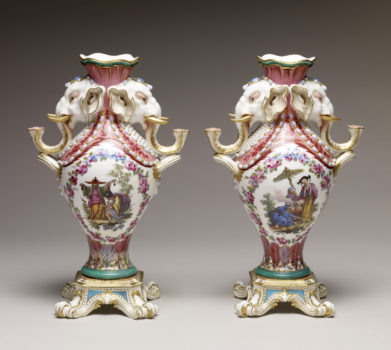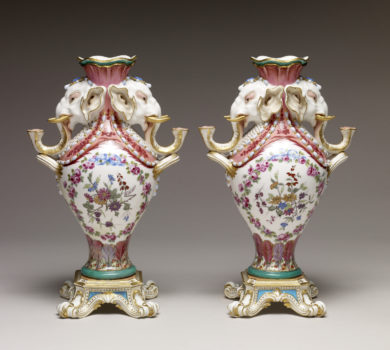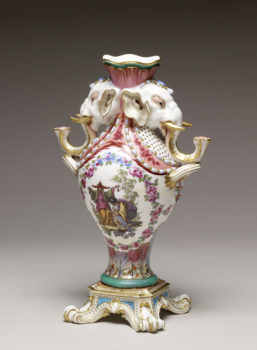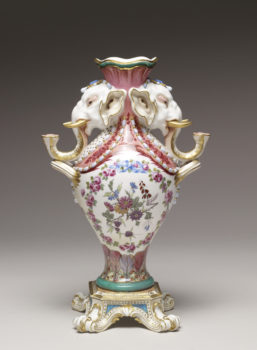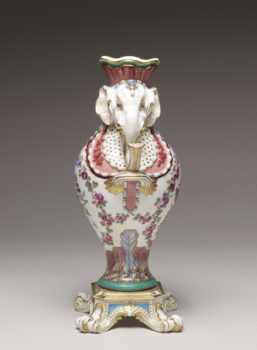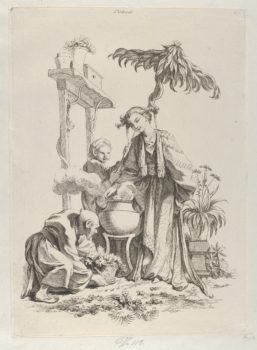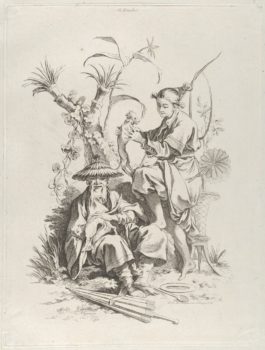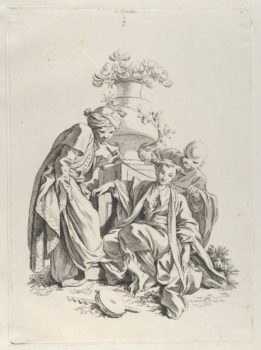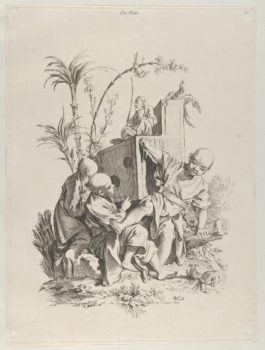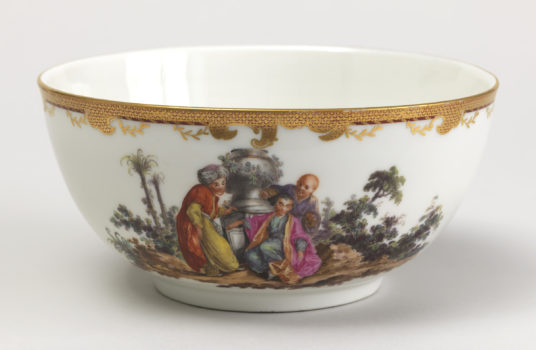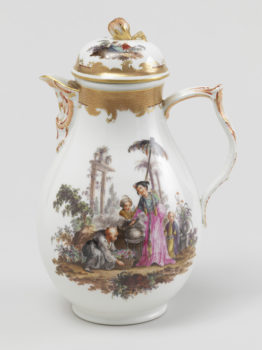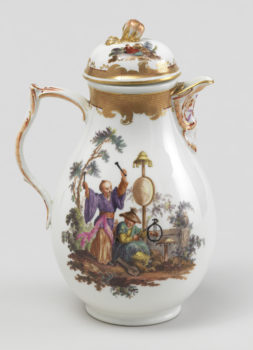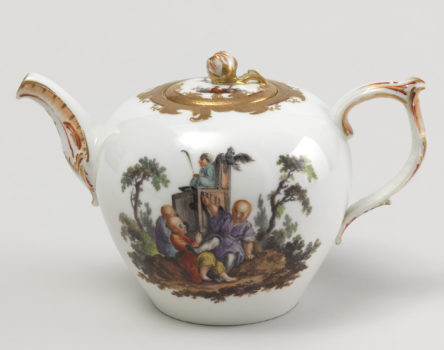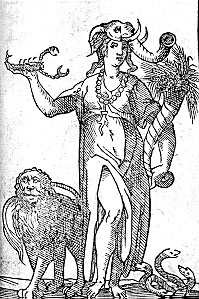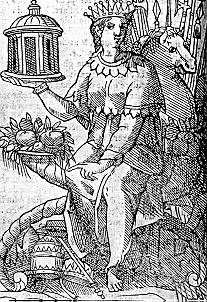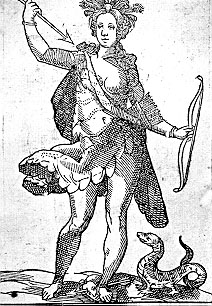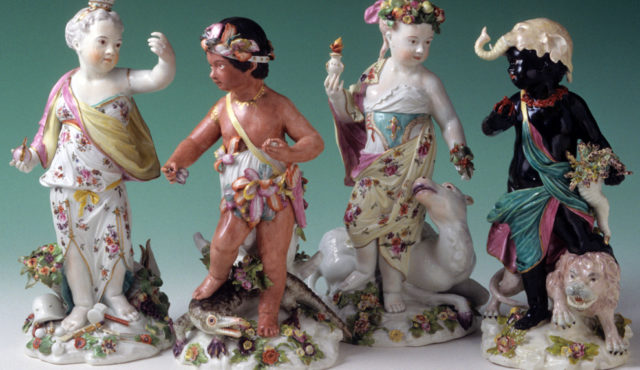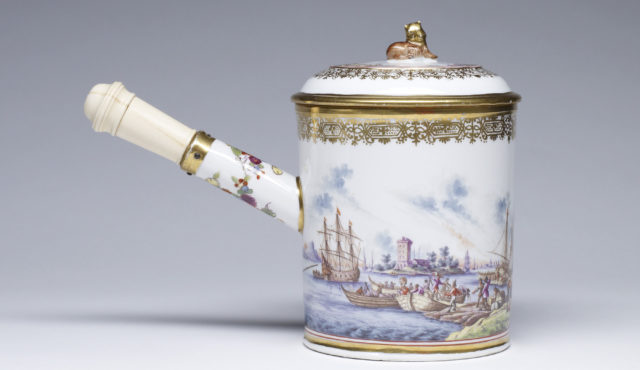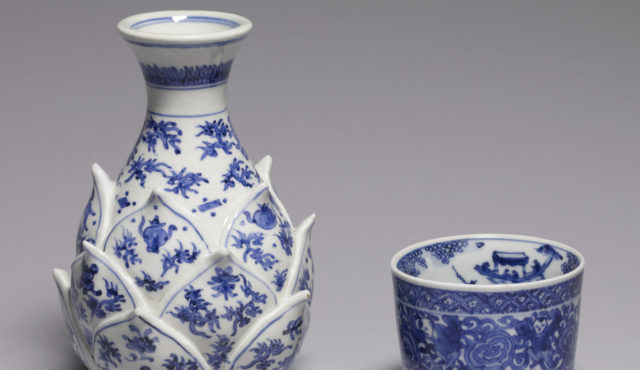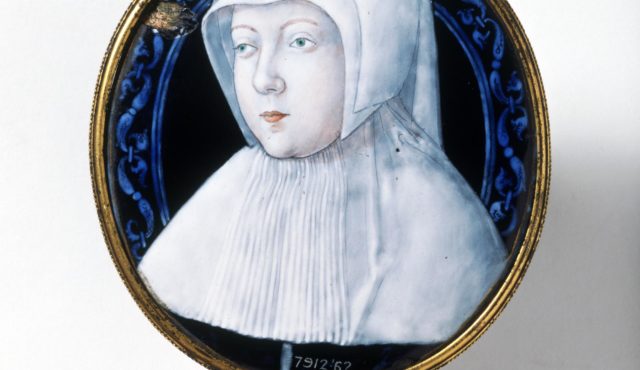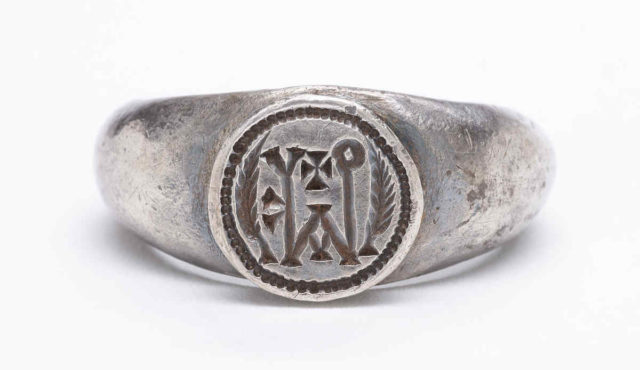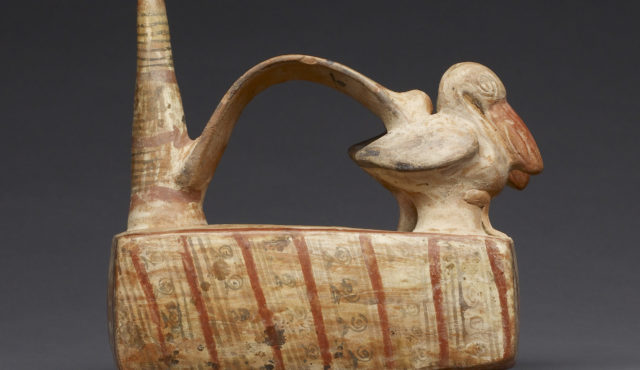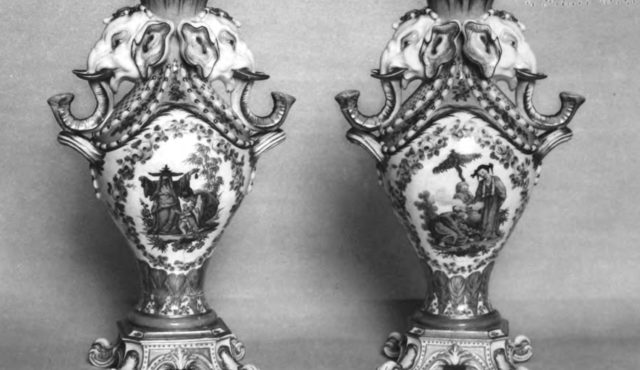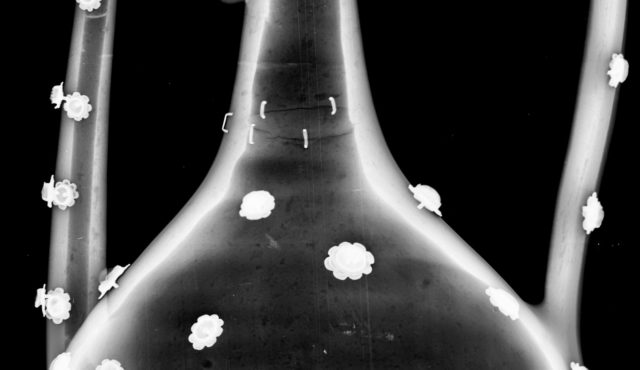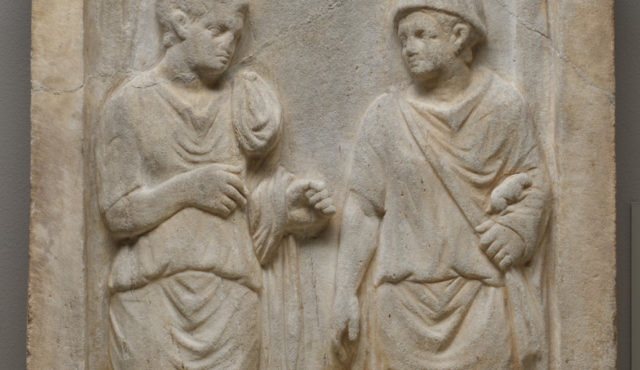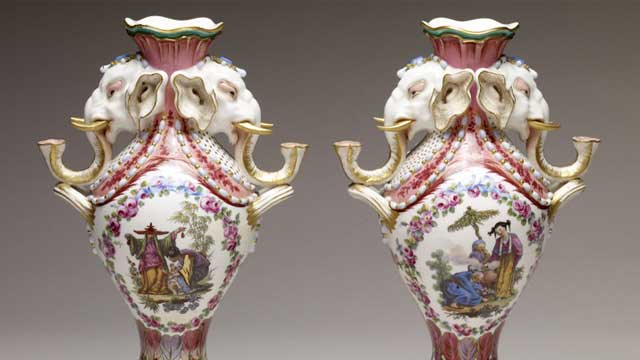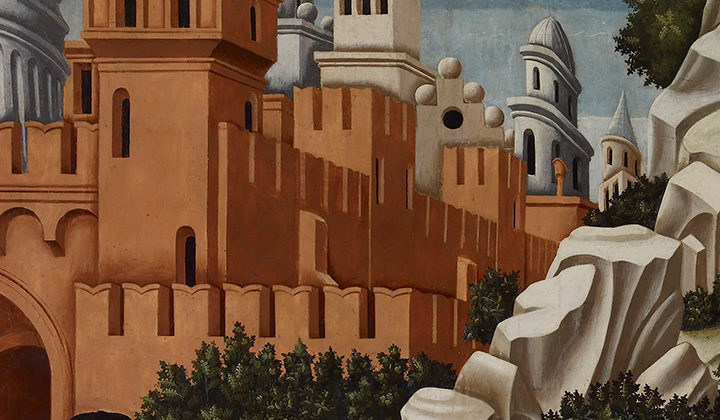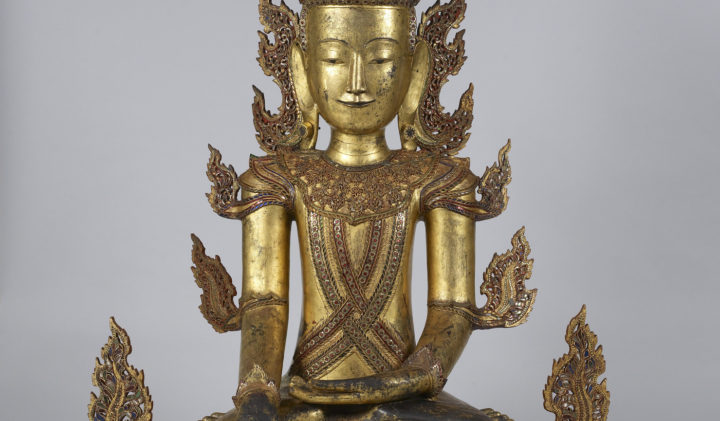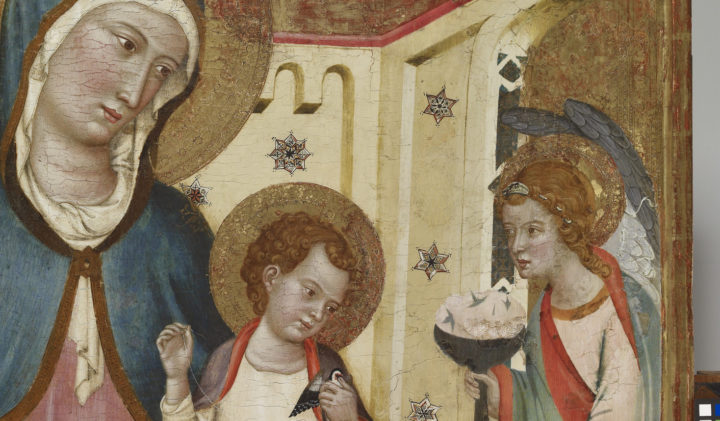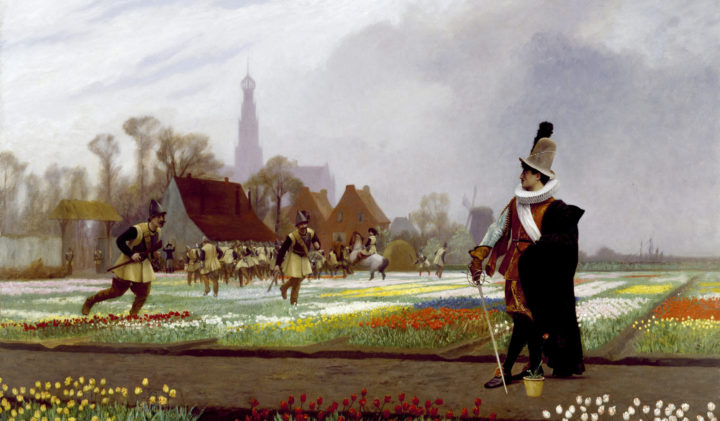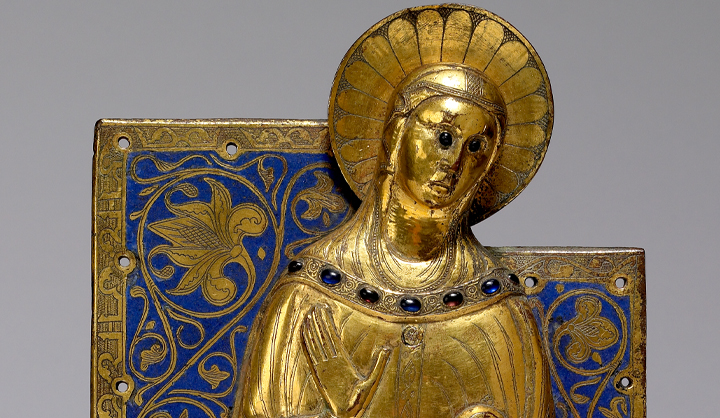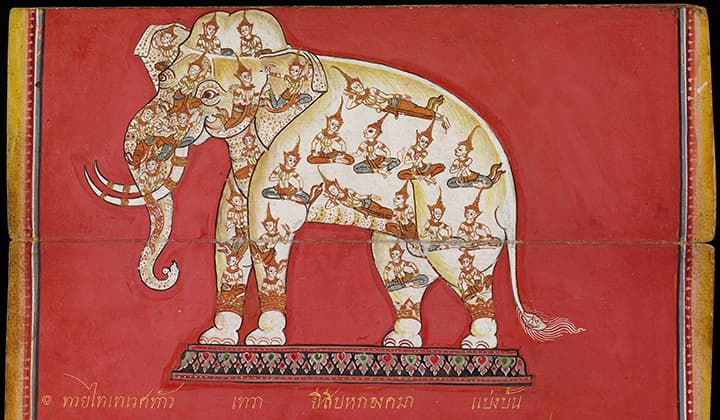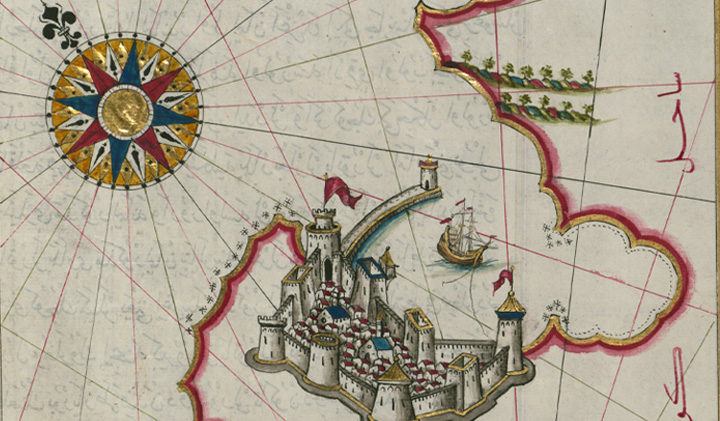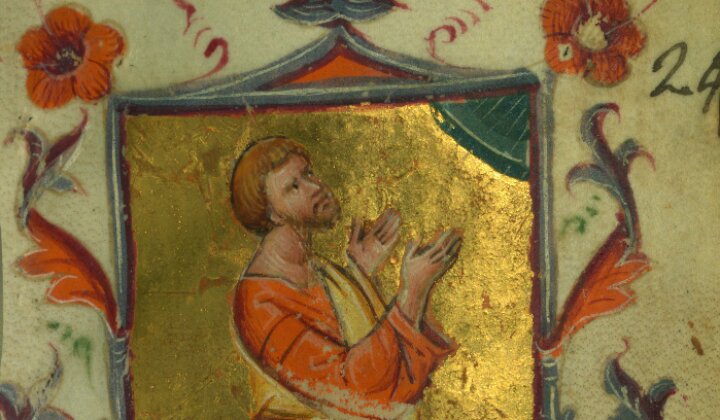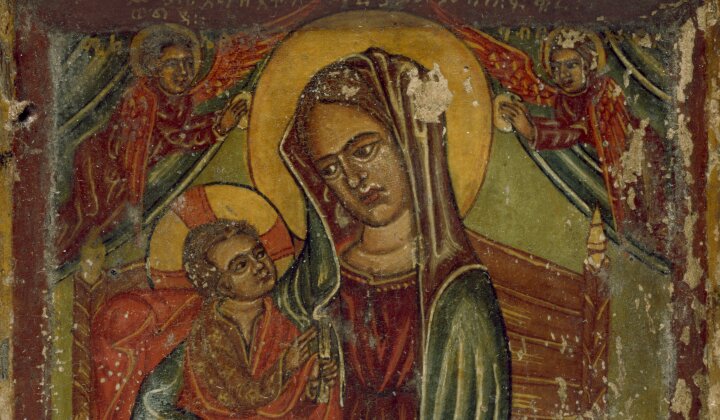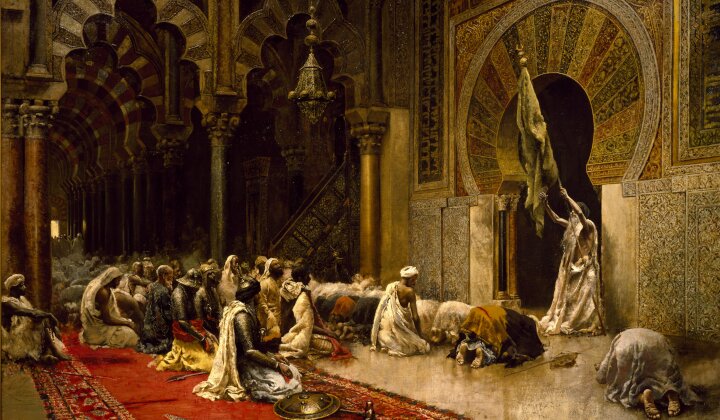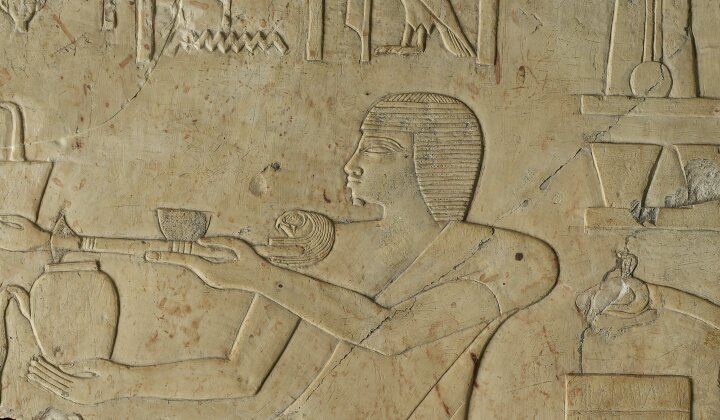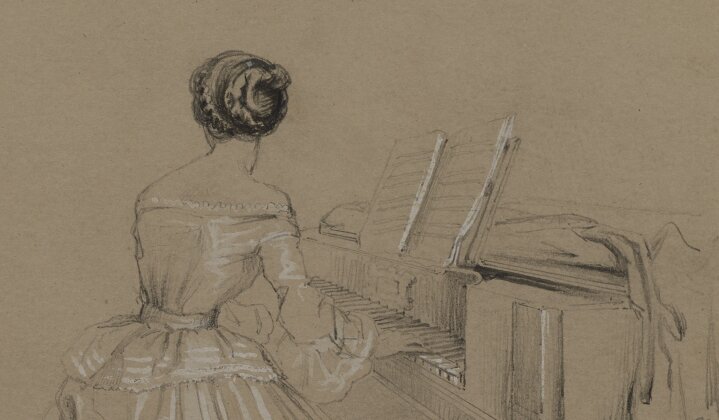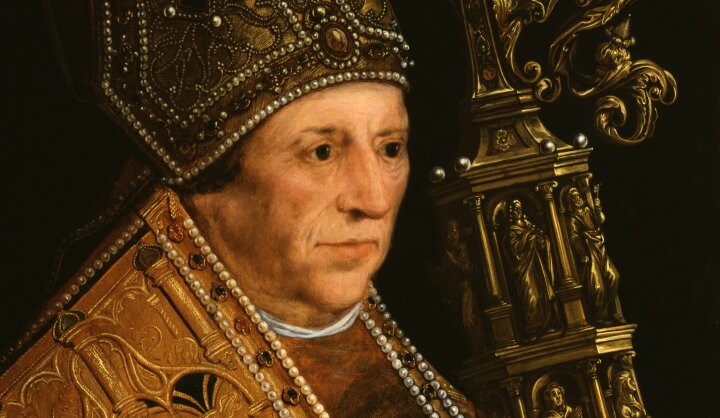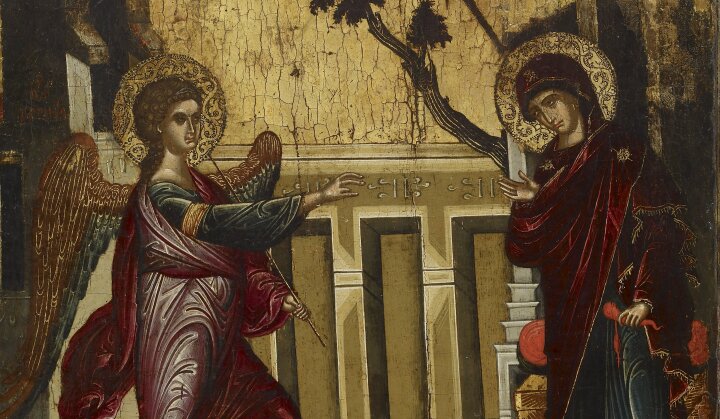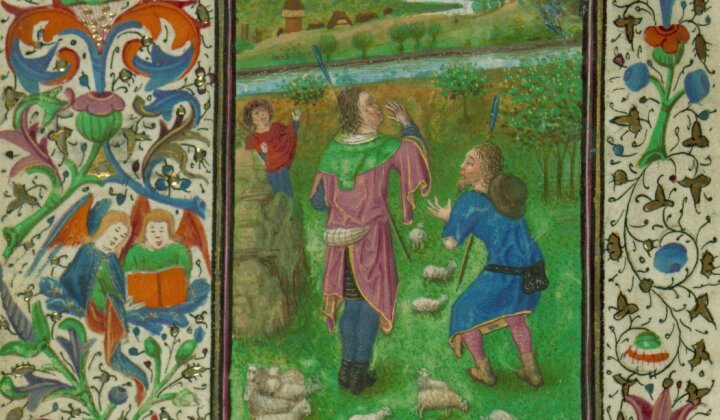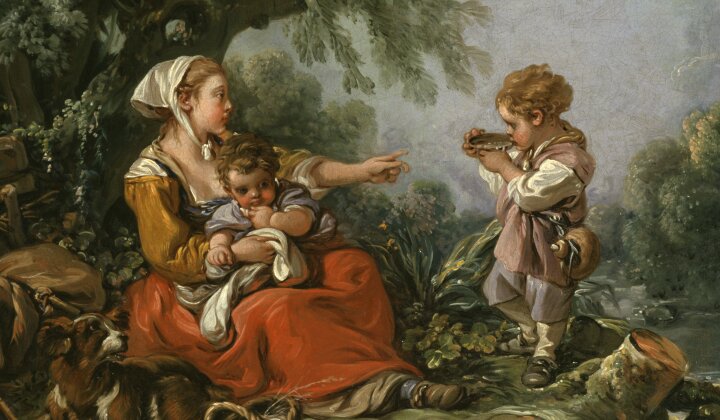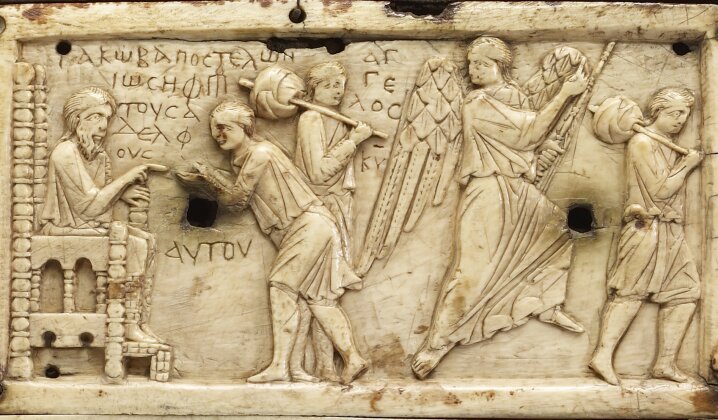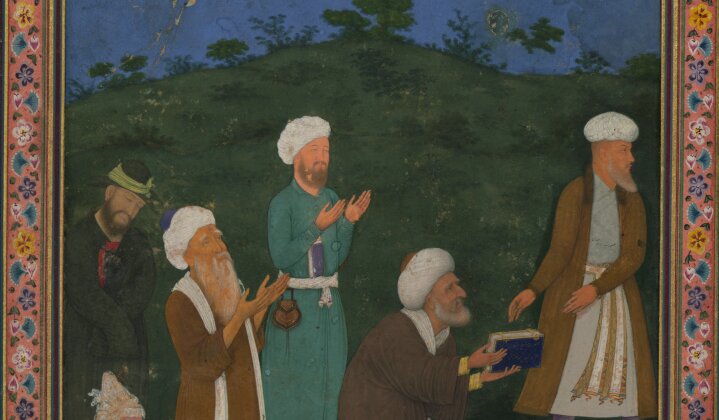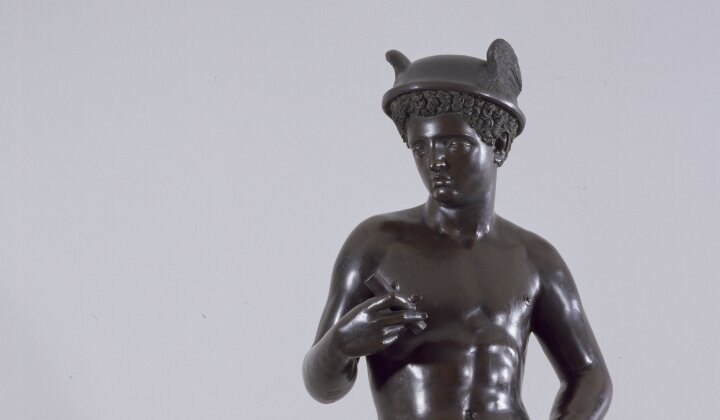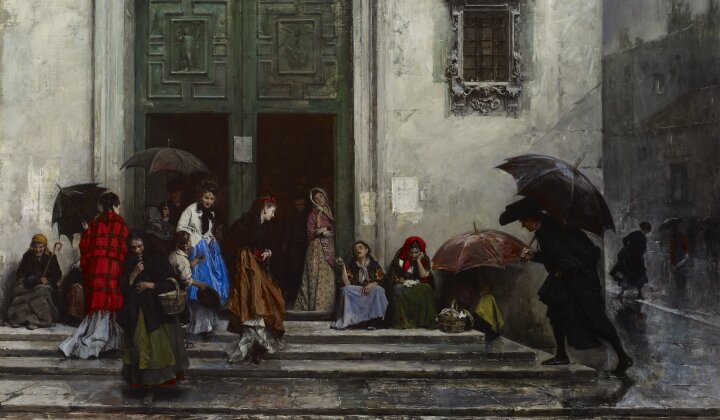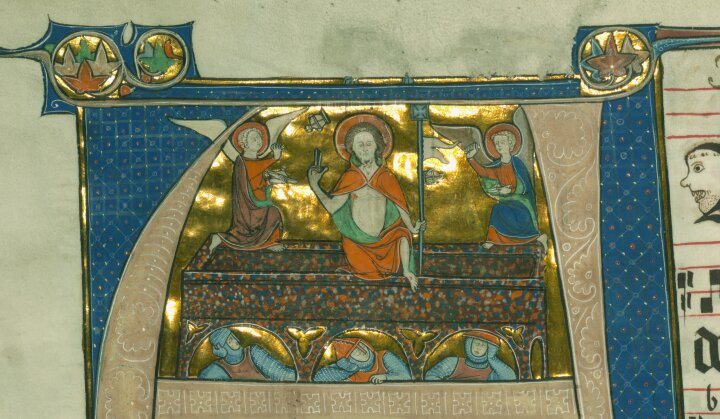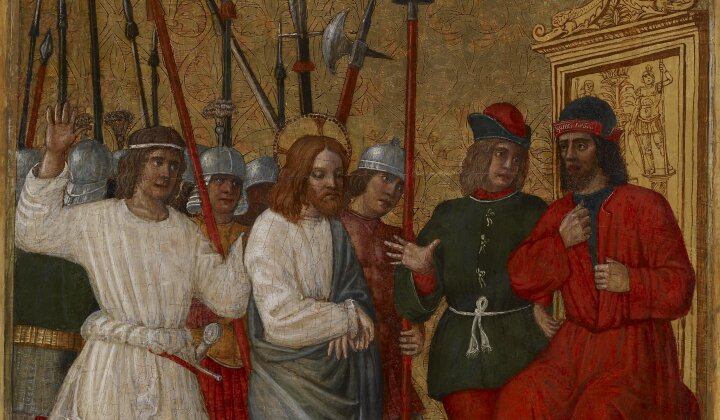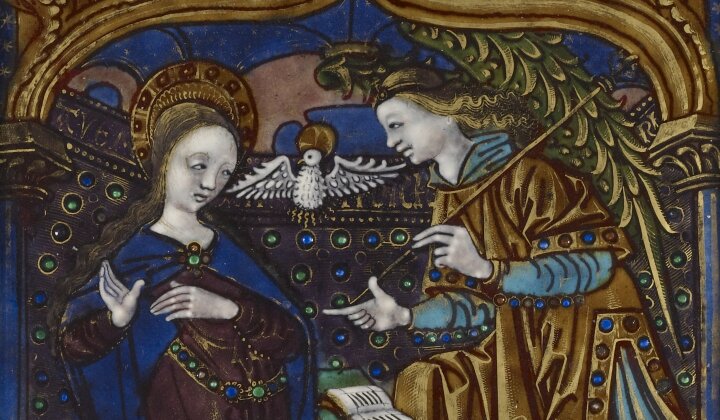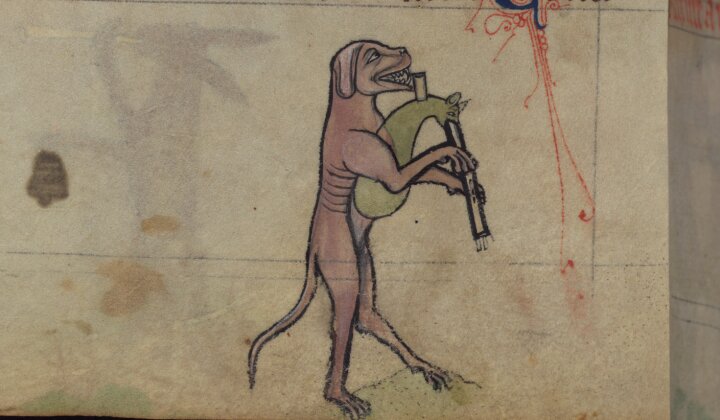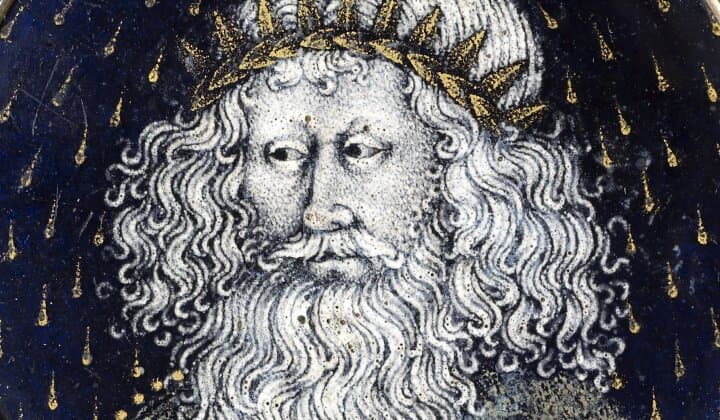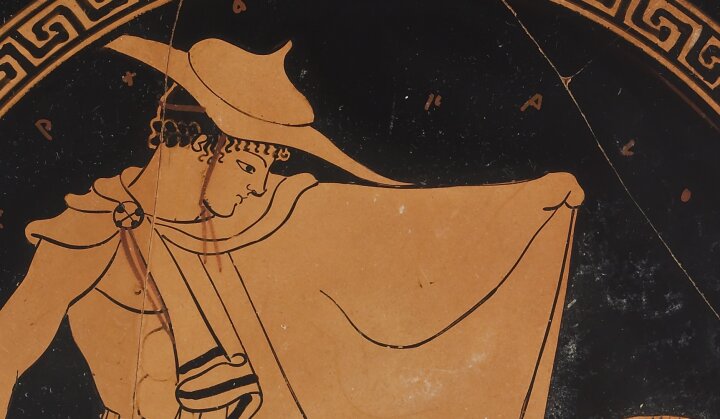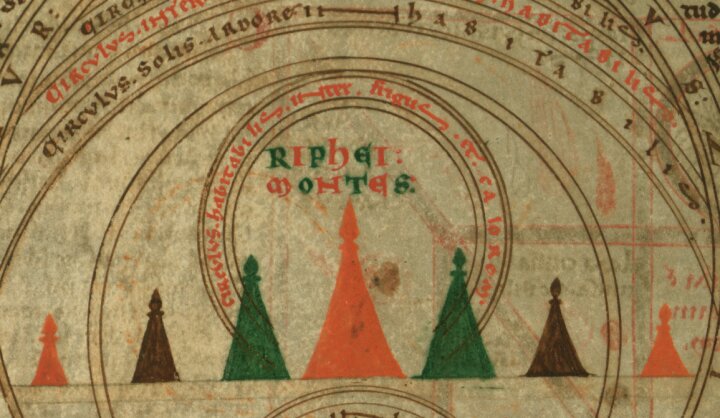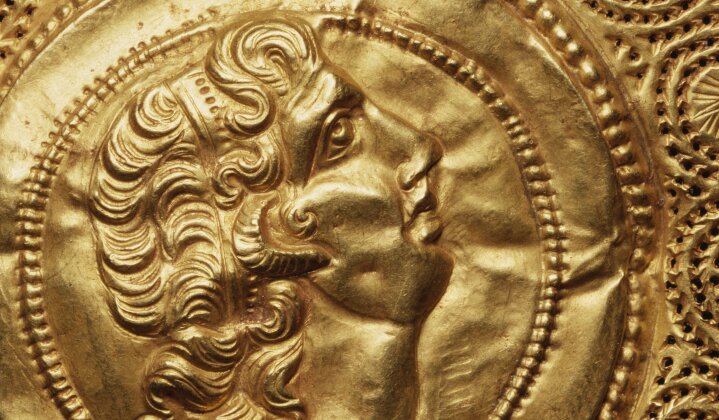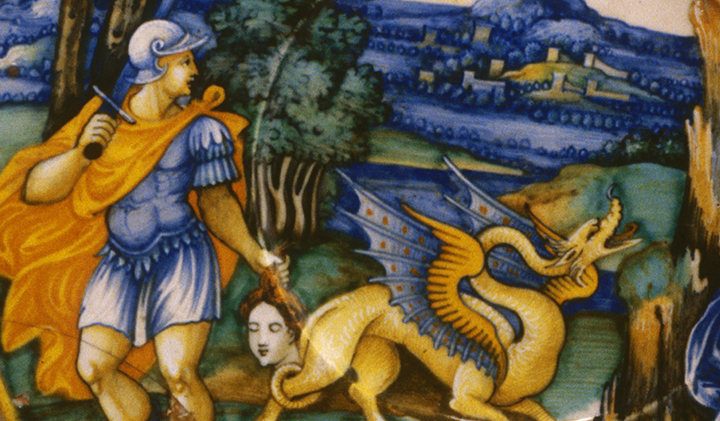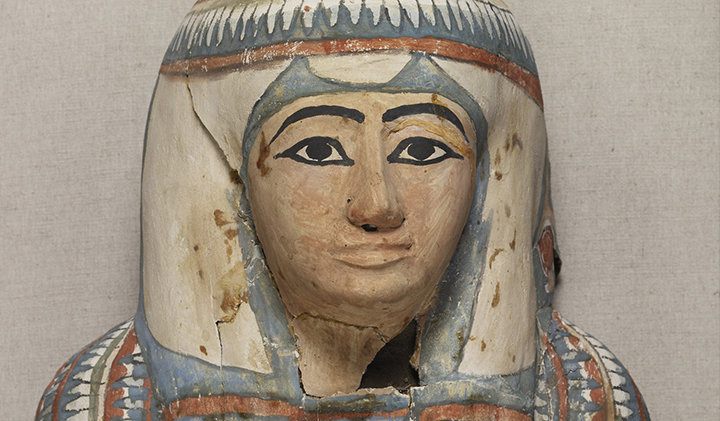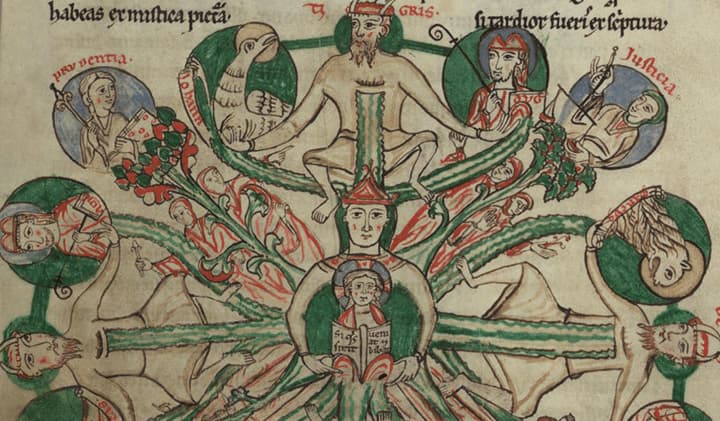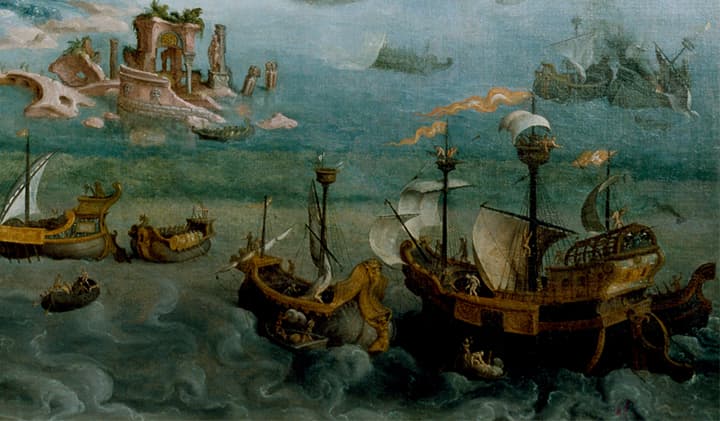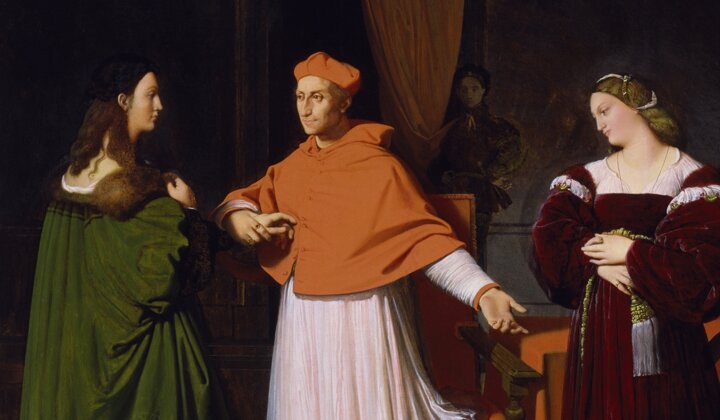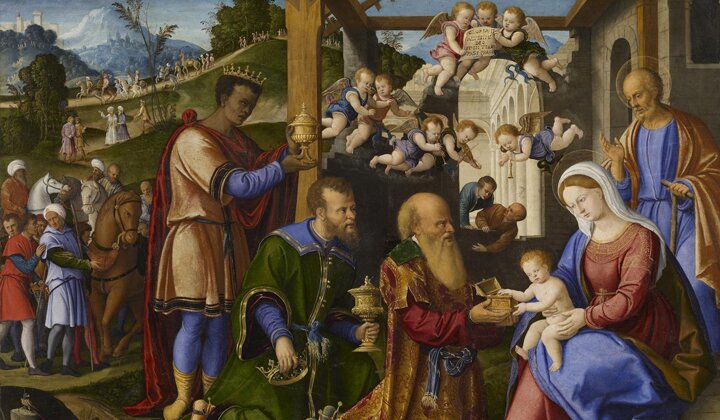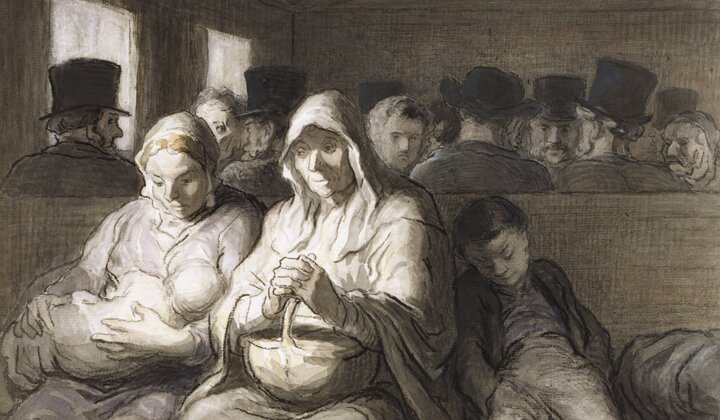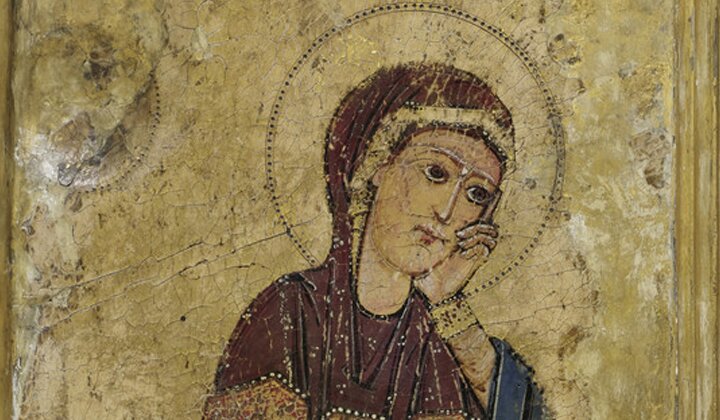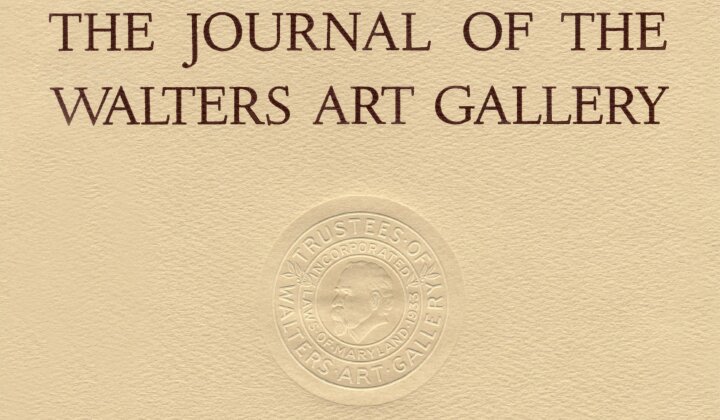Whether they beguile or repulse you, the pair of Sèvres porcelain elephant-head vases (Vases à tête d’éléphant) at the Walters Art Museum inevitably draws a reaction (fig. 1). Two meticulously sculpted, milky-white elephant heads jut out from the neck of each vase. The animals’ upturned trunks, attached like handles to the curved body of the vase, once held sockets for candles (fig. 2). At the center of each vessel is painted a bright polychrome scene of “Chinese” human figures encircled by decorative florets; the other side of the vases features a central flower arrangement. The sheer amount of surrounding rococo detail—feathers, faux beads, and flourishes of gold trim—overwhelms. Ordinarily on view in the museum’s European ceramics galleries, these mid-eighteenth-century curiosities were a focal point of the initial display in the 2018 reopening of Hackerman House at 1 West Mount Vernon Place, where they could be appreciated from all sides. Still, one can only imagine the effect of candlelight catching the glisten of pink-and-white painted enamel as the vases were displayed in an eighteenth-century interior on a mantelpiece or commode alongside porcelains of different shapes, as part of a set of matching wares, or garniture.
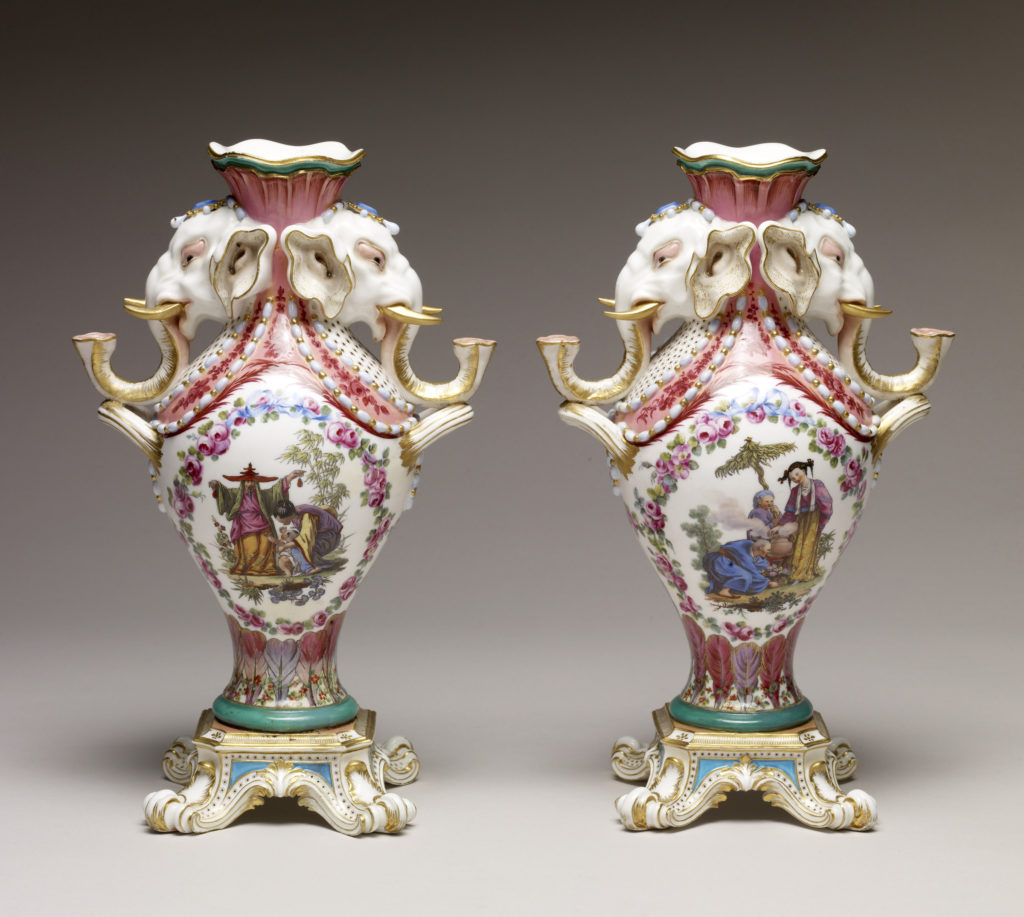
Sèvres Porcelain Manufactory, Charles Nicolas Dodin, Pair of Vases (Vases à tête d’éléphant), ca. 1760, soft-paste porcelain with enamels. The Walters Art Museum, Baltimore, Museum purchase, 1941, acc. no. 48.1796-7
Designed around 1756 under the artistic direction of Jean-Claude Duplessis le Père (ca. 1695–1774) at the Royal Porcelain Manufactory at Sèvres, the vases combined novelty in color and shape with technical difficulty. Pairs of vases were often sold with an ornate, boat-shaped potpourri vase (potpourri à vasseau) that, when filled, would add perfumed aroma to the experience of the works in situ. Three Sèvres porcelains of a five-piece garniture purchased in 1758 by Louis-Joseph de Bourbon, prince of Condé (1736–1818), are at the Metropolitan Museum of Art, and when displayed together they give an idea of the objects’ interaction.[1] Another famed patron of the Sèvres factory, Madame de Pompadour (1721–1764), a mistress of King Louis XV of France (reigned 1715‒1774), owned at least three pairs of the elephant-head vases and two potpourri boat vessels.[2] Not only did she inspire the invention in 1757 of the intense pink ground color on the vases, she collected pieces with Chinese scenes painted by the skilled miniaturist Charles-Nicolas Dodin (1734–1803), who was responsible for the scenes on the Walters’ elephant-head vases. Dodin’s paintings echoed the chinoiserie designs of her favorite rococo artist, François Boucher (1703–1770).[3]
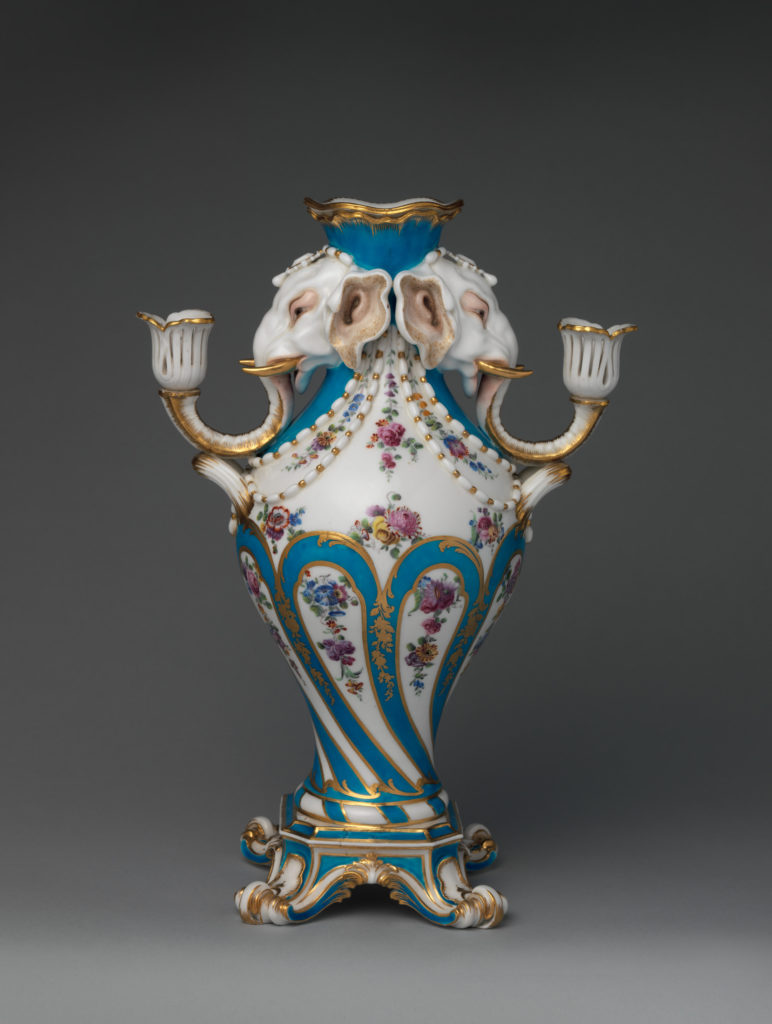
Sèvres Porcelain Manufactory, Modeler: Jean-Claude Duplessis le Père, Elephant-head vase (Vase à tête d’éléphant), 1758–62, soft-paste porcelain. The Metropolitan Museum of Art, New York, Gift of Mr. and Mrs. Charles Wrightsman, 1976, acc. no. 1976.155.61
This essay will consider the Walters’ vases as devices of what might be called cross-cultural synesthesia. How do the vases produce an uneasy sensory overload by mingling different orders of chinoiserie imagery, animal and human, sculpted and painted? I will suggest that ornamental art—rather than being only “decorative”—participates in ethnographic and colonial discourse even as it resists fixed interpretations. What can a decorative object tell us about the history of East–West exchanges as they shaped the emergence of new racial thinking in the eighteenth century? How did Europeans’ color-based hierarchies among humans correlate with their artistic innovations in color and form that borrowed from Asian ornament? At this proto-capitalist moment, consumers’ bodies and identities were increasingly self-fashioned by foreign imports that entered the space of the home. Even a pair of vases could, from the interior of an elite bedchamber or drawing room, reference the larger flows of transcontinental trade and its discontents.
Far from being passive furnishings, objects orient consumers in relation to each other and their environment. We get to know three-dimensional things by handling them, arranging them, even seeing them reproduced in visual art and literature. In the eighteenth century, porcelain and chinoiserie artifacts were generally collected and comprehended as pieces of larger sets.[4] However important it is to study objects in their original settings, my focus on the formal properties and iconographic sources of one unusual and uncannily doubled pair—two vases, four elephant heads—also takes seriously the power of discrete artifacts to arrest the eye, generate stories, and, as material metaphors, activate the critical imagination. The making of a metaphor is itself a process rife with decontextualizing (and recontextualizing) one thing in relation to another, or in the case of metonymy, one part in relation to a whole. In other words, I am interested as much in what the Sèvres vases can teach us about the legacy of Orientalism, as in what we can learn about these particular works of art. Today, our sense of an object’s uniqueness is undoubtedly biased by the selective practices of museum collection and display as well as our ability to behold reproductions online and up close. Yet the act of isolating and closely scrutinizing a representative example can illuminate the ways that intercultural knowledge coalesces, assumes material form, and accrues racial meanings over time.
Whether viewing them virtually or in person, the Walters’ elephant-head vases’ metaphorical evocation of sight, smell, taste, touch, and sound can be at once pleasurable and disorienting, to an elephantine extreme. The elephant’s open mouth, ears, and upturned proboscis add all five sensory dimensions to the equally evocative chinoiserie scenes painted on the body of the vase. United by undulating shapes and decorative gilding, the ornament amounts to a pastiche of Asian decorative forms that enacts the mid-eighteenth-century rage for the “Chinese taste,” or le goût chinois, later referred to as chinoiserie. The medium of porcelain itself elicited the new sensory reaction of tact flou, a French connoisseurial term used to describe the combination of porcelain’s tactility and delicacy.[5] The Sèvres factory produced three sizes of elephant-head vases between 1756 and 1762, the same years that it surpassed the output of its German competitor, Meissen. In 1710, during the reign of Augustus II, Meissen became the first European factory to successfully imitate Chinese hard-paste porcelain. Through painstaking trials, chemist Johann Friedrich Böttger (1682–1719) was able to make a version of the luminous white substance out of kaolin clay and alabaster (calcium sulphate), but only in 1724, after his death, did the factory discover the key ingredients of feldspar and quartz used by the Chinese to fuse the kaolin under high temperatures and produce the desired translucence.[6] In this era of experimentation, Meissen also made elephant-handled candelabras and vessels that might have been based on Chinese and Japanese precedents, and it is possible that these shapes inspired the elephant-head designs of Duplessis at Sèvres.[7]
Economic and cultural historians have long studied how Chinese technology spurred European manufacturing in the eighteenth century, and porcelain design was part of this trend in imitating and attempting to outperform China.[8] Of the twenty-two extant Sèvres elephant-head vases, the Walters pair is unusual in featuring figural Chinese scenes within the floral-framed reserves (background areas reserved for painted decorations). The painter of the scenes, Charles-Nicolas Dodin, focused on perfecting “the Chinese manner” of painting between 1760 and 1763, and his contribution to the elephant vases was part of the factory’s innovation in three areas inspired by chinoiserie: “moulded ornament, brilliantly colour[ed] grounds and exquisitely painted miniature scenes set within shaped reserves.”[9] To execute the scenes, Dodin probably had at his disposal numerous print sources on Chinese design, in particular, celebrated Rococo court artist François Boucher’s chinoiserie series The Five Senses (Les Cinq Senses) (1740), in which each sense—smell, hearing, touch, sight, and taste—is allegorized by an ensemble of lithe Chinese figures engaged in a central activity of perceiving (fig. 3).
The reserve of one Walters vase clearly replicates Boucher’s Smell (L’Odorat), printed and published by Gabriel Huquier (fig. 3a, fig. 1). An Asian female figure with hair tied into horizontal plaits stands above a cauldron of billowing incense, while a juvenile holds a leafy parasol above her head and a man places a basket of flowers at her feet. This vision of China—defined by heathen ritual and imperial spectacle—reiterates the religious exoticism associated with Eastern empires. So too does the image painted on the other Walters vase: a portly priest figure with a mustache and goatee in a cinctured robe and three-tiered hat stands with arms outstretched. In each hand dangles one of what scholar Carl Christian Dauterman has called “a pair of tintinnabula.”[10] However, the objects do not resemble bells, but rather small pouches, or perhaps European style castanets.[11] Whether or not these are even noisemakers is debatable, and yet Boucher’s Hearing (L’Ouïe) has been identified by the Walters and others as Dodin’s source (fig. 3b, fig. 1).[12]
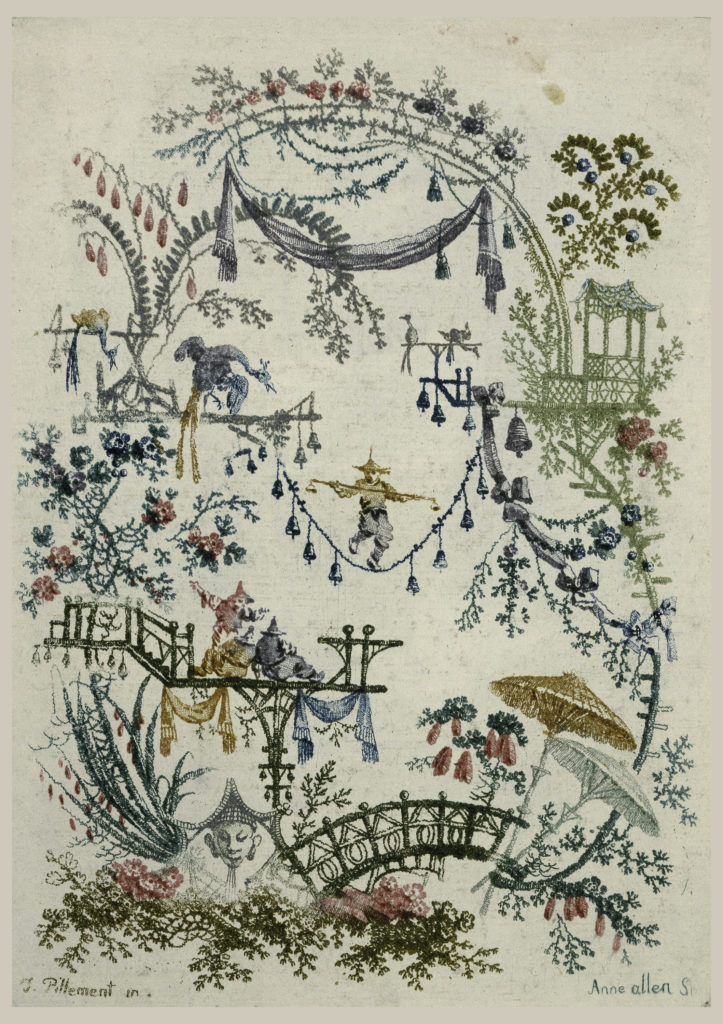
Jean-Baptiste Pillement (1728–1808), Print, ornamental design from “Nouvelle suite de cahiers chinois a l’usage des dessinatueurs et des peintres”, after 1775, etching with colored inks à la poupé on off-white laid paper. Cooper Hewitt Smithsonian Design Museum, New York, Purchased for the Museum by the Advisory Council, acc. no. 1921-41-21
Upon close examination, though, Boucher’s print differs significantly from Dodin’s painting. Boucher depicts two musicians, a slim bald man brandishing timpani sticks before an upright cymbal stand, and a seated man playing a round, four-stringed lyre on a stick; they are surrounded by other pseudo-Chinese instruments with dangling bells.[13] Neither the scene nor the timpani player’s stature, costume, or features are rendered in Dodin’s vase painting. While Dodin’s central priest figure vaguely resembles any number of bell-bearing performers or religious worshippers that appear in other chinoiserie designs (fig. 4, fig. 1c), this is not an explicitly musical or sonic performance. Instead, Dodin places his priest figure before the enrapt spectators of a woman and infant, a figural pairing appearing in a miniature attributed to Dodin on a different Sèvres vase held at the J. Paul Getty Museum (fig. 5, fig. 1c).[14] Thus, while Dodin probably worked from one or more chinoiserie or Chinese print sources, the exact source of the miniature on one of the Walters vases remains elusive.
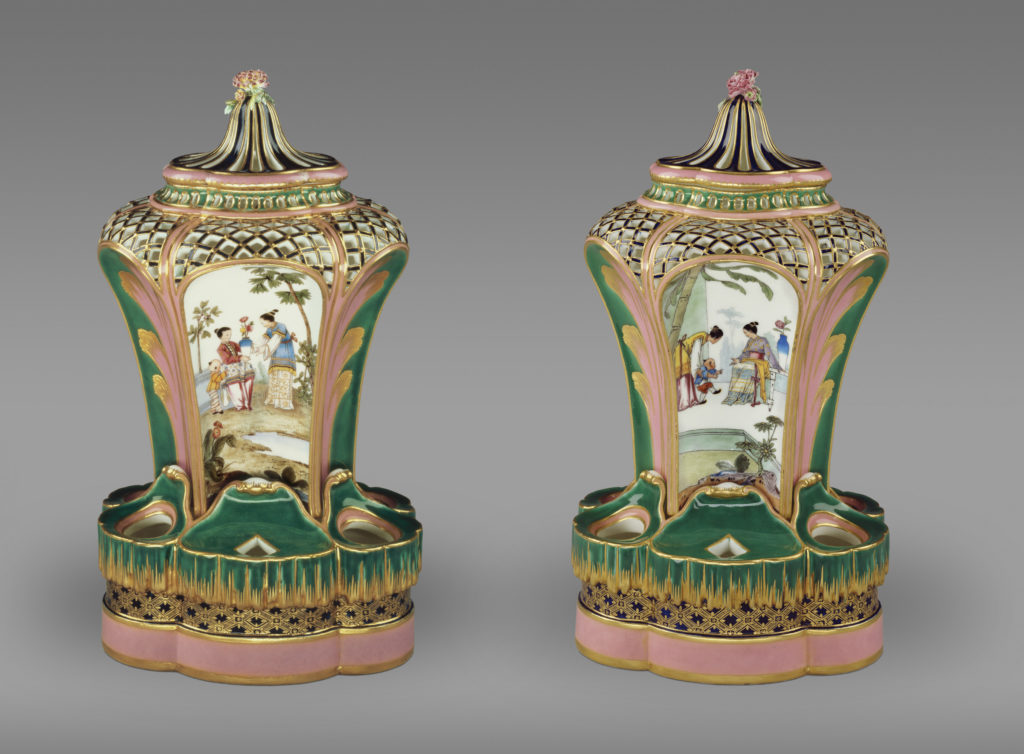
Sèvres Porcelain Manufactory, Decorator: Charles-Nicolas Dodin, Pair of Vases (pots-pourris fontaine or pots-pourri à dauphins), 1760, soft-paste porcelain, bleu lapis, blue, pink, and green ground colors, polychrome enamel decoration, and gilding. The J. Paul Getty Museum, acc. no. 78.DE.358
The misattribution of Boucher’s Hearing further illuminates the cross-cultural synesthesia at work in the vases’ perceived Chinese-ness. Given the popularity of the Five Senses, it seems logical to pair Smell with another sense in the series like Hearing, especially when these designs did appear together on other porcelains of the period, such as vessels in a Berlin Porcelain Factory chocolate and tea service in the Cooper Hewitt collection (fig. 6).[15] Indeed, ornamental chinoiserie figures were usually imaged as interactive ensembles within a series or an iterative design pattern: one Orientalist element begets another. By assembling somewhat interchangeable Chinese figures (priest, musician, servant, spectator), both Boucher’s prints and Dodin’s chinoiserie interpretations naturalize—through exotic foreigners—the ideas of sensory interconnectedness and what we now call synesthesia, the phenomenon where one sense impression is triggered by the experience of another sense. In the seventeenth and eighteenth centuries, synesthesia was actively debated within scientific circles that challenged the primacy of visual sensation. Was it possible to feel or smell color? How might foreign commodities, materials, and surfaces, even skin, take on heightened dimensionality and tactility when magnified under a microscope?[16] Certainly, the visual kaleidoscope of pinks, greens, yellows, and blues emanating from the Sèvres vases’ painted chinoiserie reserves is at once tactile and theatrical. Each painted scene of “Chinese” costume and gesture echoes the tradition of French and Italian burlesque comic operas, pantomimes, and ballets, which staged Chinese types taken from travel ethnographies, export art, and chinoiserie design books.[17]
Notably, Boucher considered Chinese subjects “perhaps his favourite passion,” and Boucher’s style has been called the “physiology of sensuous experience.”[18] Tactile interactions between human and non-human elements govern each scene of the Senses. Curiously, the series actually contains six senses, as there are two versions of Touch. One oozes human-animal intimacy: a man and woman pet catlike figures while the woman’s bare foot appears to brush the seated man’s left thigh (fig. 3c). The other version, pictured on the Cooper Hewitt’s Berlin Porcelain Factory bowl, is differently erotic: two men use slender stalks to tickle a seated woman (fig. 3d). The act of stimulation echoes the deviant sensuality of many chinoiserie vignettes, in which ambiguously gendered master-and-servant figures engage in lavish pastoral leisure activities of consumption, domination and prostration, and sometimes even in scenes of torture.[19] Moreover, the voyeuristic acts of spectatorship staged within chinoiserie scenes foreground the very practice of perceiving, or what scholar Eric Hayot has called the “example-effect” of European hypothesizing about “the Chinese body in pain.”[20] When the human senses are allegorically and ornamentally coded “Chinese,” ironically, the universality and alterity of Chinese-ness is simultaneously presented.[21]
At once eroticized, miniaturized, and infantilized, effete Asian bodies such as those in Boucher’s prints exhibit the extremes of the human sensorium. They experience and perform the novel combination of pleasure and pain, an effect of sensory overload that Edmund Burke (1729–1797) theorized as an aesthetic of the sublime.[22] Boucher’s scenes of Chinese touch, which enact erotic tickling or animal petting, resonate with the mixed affect of Burke’s sublime and the queerness of tactility as described by French anatomist Claude-Nicolas Le Cat (1700–1768): “One Perfection of the Touch . . . is Tickling, a Sort of Hermaphrodite Sensation; productive of Pleasure, of which it is an Extreme; and of Pain, of which it is as it were the first Degree.”[23] While they do not explicitly feature Boucher’s Touch, the pair of Sèvres vases do bring together two orders of tactile, or haptic, chinoiserie—sculptural and pictorial—on the body of each vase. Together, the chinoiserie elephants and human figures orient the viewer toward a mixed or “hermaphrodite” tactility through the medium of soft-paste porcelain, a form of Eurasian white matter that assimilates Chinese difference into a sign of artisanal innovation.
Whereas the painted Chinese figures exhibit an ornamental liveliness and haptic visuality derived from Boucher’s and others’ designs, they are far from lifelike when compared with the sculpted fleshly elephant ears. (The prominence of the ears might contribute to the association of one of the painted miniatures with Hearing.) The difference between the sculptural and the pictorial elements can be understood as different metaphorical registers: between synecdoche and metonym, or perhaps even between symbol and allegory. As articulated by German Romantic writer Friedrich Schelling, “The symbol is a metaphysical something in sensuous representation” whereas allegory “sees an abstract meaning in simple reality. It is not emotionally felt, as is the symbol, but thought out, i.e., constructed.”[24] That is, the elephant heads seem to enact (symbolically) the sensory perception referenced more abstractly (allegorically) by the miniature paintings. The scenes of Chinese spectatorship painted in color in the reserves on the Walters’ vases reinforce the corporeality of elephant sensation, including its whiteness and its highly receptive trunk and ears; their synecdochical body parts stand in for civilizational and, as discussed below, racial difference. Their symbolic animal realism creates an immediacy of presence that verges on the monstrous, in contrast and in combination with the two-dimensional carnivalesque Dodin miniatures. The chinoiseries’ combined, “hermaphroditic” effect is perhaps best captured by architect Sir William Chambers’s (1723–1796) description of Chinese gardens: “Their whimsical combinations [exhibit] the most magnificent confusion imaginable. Their artists knowing how powerfully contrast agitates the human mind.”[25]
A sixth sense is normally an unproven intuition or extrasensory perception, an uncanniness, which in the case of the Sèvres pair also results from the recursiveness of the vases’ shapes and influences: two sets of elephant ears, a doubled sense of touch, vases that double as candelabras. If synesthesia occurs when one sense is activated by another, this crossing of perceptions is provoked by the disorienting and reorienting effect of chinoiserie, itself a product of European and Asian mixing. Each example of chinoiserie conjures vitality and multisensory interaction, but the interplay between chinoiseries and contrast of their colors and forms—what Jonathan Hay has called a “cross-referencing of surfaces”—underlines the impact of their elephantine aesthetics.[26]
Monstrosity and Ornamentalism
By the mid-eighteenth century, the vogue for Asian imported porcelains, lacquerware, textiles, and furnishings in European aristocratic courts and middle-class homes drew criticism as well as enthusiasm. Consumers expressed their ambivalence, if not disdain, toward the fanciful, mix-and-match designs of floating pagodas, outsized botanicals, flying boats, and “heathen” robed figures that seemed to defy Western logic and perspective. The poet Richard Graves described the interior of an English villa decorated in the Chinese taste:
All that rich China’s marts display,
Grotesque in shape, in colors gay;
Enamell’d jars, or painted screens,
Fat idols, pagods, mandarines![27]
Cultural historians have noted the simultaneous desire for and disavowal of Chinese aesthetic influence in the period, a dynamic that shaped British nationalist and cosmopolitan sensibilities well into the twentieth century. Art historian and television broadcaster Lord Kenneth Clark of Saltwood, for one, voiced his ambivalence toward the Walters’ elephant-head vases when he called them “examples of bad taste,” “ridiculous and slightly vulgar,” and “as ugly as one could wish.” He later added, “I have now become quite fond of them, and if anyone offers me a Sèvres elephant vase on my birthday, I will accept it with pleasure.”[28]
In Britain, to be “Chinese” could mean a number of things at a given moment in the eighteenth century: ingeniously British, anti-French, anti-classical, rustic, Gothic, elegant, excessively ornamented, delightfully irregular. Whereas Eugenia Zuroski identifies a structuring relationship between “English selves and Chinese things,” David Porter has studied British and French chinoiserie as commercial phenomena built upon imperial “fantasies of monstrous beauty,” fantasies as played out both between and within empires.[29] Religious, aesthetic, and economic forms of Chinese “monstrosity” signaled China’s unassimilable foreignness, varyingly characterized as mongrel, immoral, wild, eclectic, or illegible.[30]
Monstrosity is an apt framework for us to interpret the mixture of bestial and ornamental shapes and forms that comprise the lingering “bad taste” of the Sèvres two-headed elephant vases. In 1728, the British encyclopedist Ephraim Chambers defined a monster as “a living thing, degenerating from the proper and usual Disposition of Parts, in the Species it belongs to. As when there are too many Members, or too few; or some of ‘em are extravagantly out of proportion.”[31] Adding to this portrait of disproportionate and excessive parts, natural historian Georges-Louis Leclerc, Comte de Buffon (1707–1788), underscored monsters’ resistance to classification when he wrote, “[being] neither the one nor the other, is a kind of monster, because it unites the attributes of two such different genera and resembles none of those models presented to us in the grand classes of Nature.”[32] While Buffon focused his studies on animals, the eighteenth-century British botanist John Hill similarly described the effects of plant reproduction: “By Monsters, among Plants, Naturalists mean such as have been produced by the Copulation of two distinct Kinds.”[33] Coincidentally, Hill took a keen interest in the phenomenon of double-flowered plants and noted the common occurrence of excessive petals in the exotic Chinese specimens he collected, studied, and painted. The monstrous qualities of unruly repetition, non-resemblance to a source, and crisis in categorization could well describe the Sèvres vases.
As early modern European religious and medical understandings of monsters (as unnatural births, foreign peoples, or divine omens) gave way to the efforts of Enlightenment science to redefine the “natural” distinctiveness of races and species, the language of animal monstrosity was applied to aesthetic and moral evaluations of non-European cultural production. A phrase like “mongrel Chinese,” when used by author and aesthete Horace Walpole (1717–1797) in discussing Chinese taste, carried with it the idea of interbreeding and miscegenation.[34] That Chinese ornament was frequently associated with animal monstrosity points to a growing fascination with artificial nature. That is, the grotesqueness attributed to chinoiserie decoration also registered awe toward Chinese artisans’ abilities to artificially manipulate the natural materials of clay or tree sap into fantastically glossy media like porcelain and lacquer. Just as European rococo ornament blurred the line between nature and artifice by integrating shells, plants, and other organic forms into its architectural compositions of S- and C-scrolls, chinoiserie designs entwined plant, animal, human, and object life in fantasy pastoral scenes. The widespread presence of imitative Chinese-ness speaks to the formidable impact of new commodities entering European markets and the power of imitation and artifice—in some instances coded Chinese—to reconfigure the experiences of everyday life.
Monstrous beasts were very often invoked in descriptions of Chinese porcelain and design. In one eighteenth-century account, the British satirist John Shebbeare described chimney-piece ornaments thus: “[A]ll the pagods and distorted animals of the east are piled up . . . on the sides of the room, lions made of porcelain, grinning and misshapen.”[35] Another popular fable, “The Tea-pot and Scrubbing-Brush,” written from the perspective of a teapot, observed that “Strange beasts were done, in taste Chinese,/ And frightful fish, and humpback’d trees.”[36] Even a proponent of Chinese ornament, Sir William Chambers, noted of Chinese landscape and garden design that “they introduce into these scenes all kinds of extraordinary trees, plants, and flowers, form artificial and complicated echoes, and let loose different sorts of monstrous birds and animals.”[37]
In eighteenth-century Europe, the unnatural nature scenes depicted by chinoiseries were also inspired by the increased proximity to actual Chinese animals and objects in settings of domestic petkeeping and royal menageries.[38] When the products of cultural mixing are seen to take on a life of their own, they in turn produce mixed affects and desires. One of the many English satires on women’s love of exotic pets, for example, describes a lady’s chamber filled to the brim with not only birds, cats, and dogs, but also “little kennels, in the Chinese taste, in almost every corner of the room.”[39] From the perspective of a male writer like Shebbeare, women’s wayward affections for foreign commodities could even result in monstrous offspring. When he remarked that wallpapers with Chinese figures “resemble nothing of God’s creation, and which a prudent nation would prohibit for the sake of pregnant women,” Shebbeare most likely referred to the longstanding theory that pregnant women could, by gazing upon artworks, imprint their fetuses with distorted impressions and give birth to monsters.[40] Masculine collecting in the form of royal zoos across Europe, including that of Louis XIV (reigned 1643‒1715) at Versailles and Kew Gardens in London, displayed live birds and quadrupeds from around the globe that were only before seen in illustrated travel books and decorative artworks. In one elaborate instance of art imitating life, Augustus II, elector of Saxony and king of Poland (1670–1733), commissioned nearly six hundred life-sized animal sculptures, including elephants, for the porcelain zoo gallery of his Japanese Palace in Dresden.[41]
The effect is the animalizing of foreignness, and “ornamentalizing” of animals. By ornamentalizing, I mean to invoke Anne Cheng’s recent study of “ornamentalism,” a historical process in which Asian female personhood is accorded racial status through the close affiliation of the feminine “yellow” body with the artifice of aesthetic objects.[42] In Cheng’s account, if people and ornament can be seen to mutually enliven each other within a commoditized world, this interrelation, fraught as it is, also refuses to relegate the Asian woman to a powerless byproduct of Orientalist dehumanization. Ornamentalism is neither a denial of the racism of Orientalism—of creating an ontological and epistemological distinction between “the Orient” and “the Occident”—as formulated by Edward Said, nor a celebration of aesthetics, but rather an object-oriented approach toward understanding what Cheng calls the “processes of racialization.” Noting the kinship—conceptual and linguistic—of the words ornamental and Oriental, Cheng also underscores a key distinction: “Orientalism is a critique, ornamentalism a theory of being.”[43]
Like Cheng, I explore ornamental processes of racialization, though in a different direction. The Sèvres vases’ multisensory registers of elephant chinoiserie allow us to glimpse the materialization of Asian whiteness as it developed in the decorative arts in relation to human and animal forms. Asian porcelain, the celebrated “white gold” of the era, was a “sensuous surface” that appealed to the eye and even the ear, given its distinctive ping when struck.[44] By the mid-eighteenth century, English and European porcelain factories were successfully replicating and industrializing the prized ceramics that had begun arriving in the 1600s from Japan and China first on Portuguese, and then on Dutch, trade ships. Yet the whiteness, delicacy, and translucence of true Chinese hard-paste porcelain was still unmatched, even by the refined soft-paste formulae produced by European manufacturers and executed in objects like the Sèvres elephant vases. Among the influential ceramics from China were red Yixing clay tea ware, milky-white “Blanc de chine” Dehua porcelain figurines, blue-and-white Kangxi-era porcelains, and other porcelains with green and pink motifs (famille verte and famille rose). The colors and textures of Ming- and Qing-dynasty export wares and porcelain design shaped trends in Western clothing and interior décor, and prompted experiments in color that produced novel glazes like the Sèvres pink of the elephant vases.
As mentioned above, objects fashion people and shape discourses even as they resist cooptation by racist and colonial ideologies, in part, owing to their inherent labor-intensive artifice, and in the case of chinoiserie, the conscious pastiche of styles and influences. In her work on the history of chinoiserie, Stacey Sloboda keenly traces the way that ornament mediates between other objects and their environments; while ornament is a “mediatory device, one that brings objects and ideas into order,” chinoiserie is “a style that self-consciously materialized the disorienting mobility and excess of foreign commodities in the domestic landscape.”[45] The animating force of chinoiserie also stems from its straddling the ornamentalism/Orientalism divide, often through levity, to produce an embodied aesthetic experience of delight and horror at the possibilities and inequities of global trade.[46] As articulated in the eighteenth century, “The Chinese artists, knowing how powerfully contrast operates on the mind, constantly practise sudden transitions . . . from objects of horror to scenes of delight.” In another account, Chinese taste was thought to turn on “anti-symmetry which [the Chinese] affect, that air of humor that they give to . . . design and composition.”[47]
In her study of the intentional playfulness of chinoiserie in the context of French court life, Katie Scott identifies an “early, comic form of Orientalism” that deliberately distinguished itself from both authentic Chinese-ness and colonial discourse, yet emerged in a time of “proto-colonialism.”[48] How might we extend these ideas of chinoiserie’s mediatory and humorous techniques to account for its orientation toward the senses and its commentary on the racialized animal/human and color distinctions taking shape in an era of Enlightenment natural history classifications? Perhaps, if chinoiserie foregrounds East–West commercial activity, this includes the circuits of Atlantic slavery in all its grotesqueness.
In appealing to the elite European consumer’s taste for ornamental animal and Asian bodies, the Sèvres elephant vases manifest an eighteenth-century Orientalist imagination through the specific medium of porcelain. The task of unpacking the novelty, and monstrosity, of the vases brings to mind the Asian fable of the blind men and the elephant. As the legend goes, several sightless men set out to determine the nature of this strange, massive beast by inspecting it through touch. Each draws a different conclusion based on the limited body part they examined; no one is privy to the elephant in its entirety. The point here is less the commonly held epistemological moral that we can only ever know partial truths. Instead, the vases can be interpreted from multiple angles—art historical, literary, scientific—to address the allegorical, iconographic, and zoological meanings that constitute their effects and affects. In what follows, I trace the cultural understandings of the elephant’s animality and its Asian-ness. This approach, while risking its own information overload, can help begin to tell a story of racial ornament and Asian whiteness, one that provokes us to rethink the relationship between Orientalism, race, and decorative art.
A History of White Elephants
For background on the Orientalized monstrosity of elephants, we can first look to early modern travel accounts that took Asian gods for monsters. Medieval European writers like Odoric of Pordenone, Marco Polo, and John Mandeville set a precedent for interpreting Indian deities and zoolatry through the lens of Christian demonology, on the one hand, and classical Greek and Roman gods, on the other.[49] Visitors to Hindu and Buddhist temples through the 1600s described the multiple heads and limbs and bestial body parts of “monstrous” sculptures. In the second half of the century, and well into the 1700s, these reports were republished by compilers of cosmographies and universal religions in a manner that I have elsewhere described as “early modern orientalism,” an accretive process with far-reaching effects.[50]

Vincenzo Cartari, Lorenzo Pignoria, Le Imagini Dei degli Antichi (Image of the Gods), 1615. Image courtesy of Special Collections Department, Bryn Mawr College Library
To take one example of how religious iconography was circulated and transmogrified, in 1615 the Italian antiquarian Lorenzo Pignoria added a section on Indian, Japanese, and Mexican deities to his edition of a popular book on classical gods.[51] He included an illustration of an adult-sized figure with three elephant heads and three arms and legs, standing next to an elephant-headed child (fig. 7). The first image combines the features of two Hindu gods, the multi-limbed Shiva Mahesamurti and the elephant-headed Ganesha.[52] The child figure, however, bears a striking resemblance to a European account of an elephant-head boy in Jakob Rueff’s book on monstrous births, De Conceptu et Generatione Hominis (1554), and reproduced in works such as Gaspar Schott’s Physica curiosa (1662) (fig. 8), which dedicates an entire chapter to sightings of humans with non-human heads.[53]
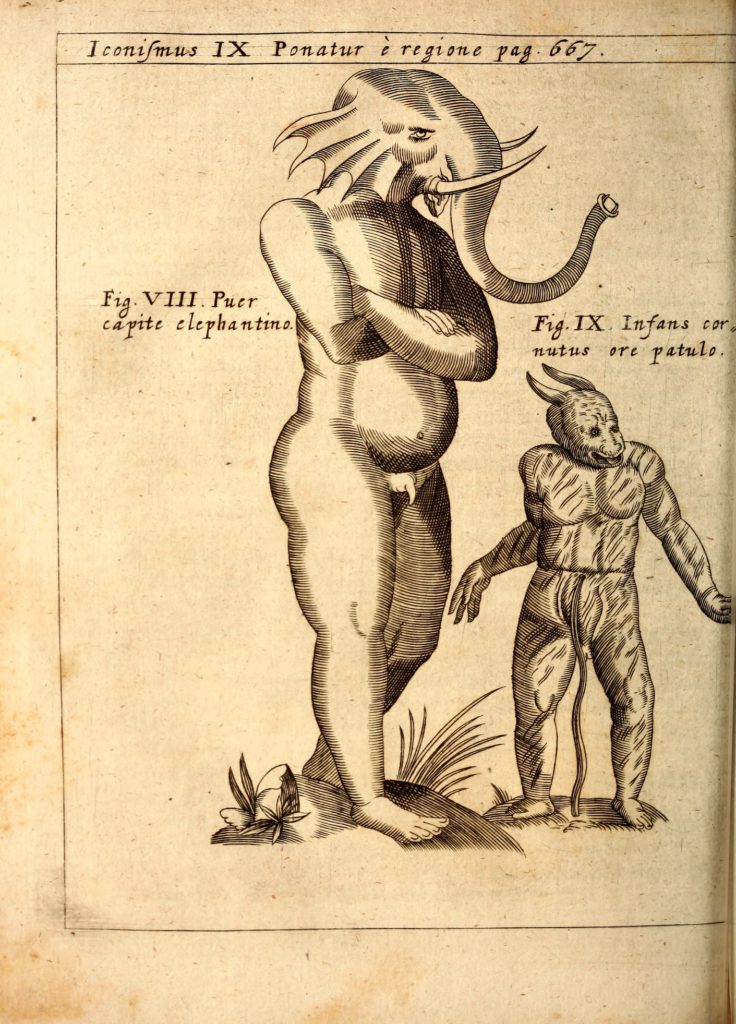
Gasparis Schotti, “Puer capite elephantino (Boy with Elephantiasis of the Head),” Physica curiosa, sive, Mirabilia naturae et artis libris,1662. Smithsonian Libraries, Courtesy of Biodiversity Heritage Library and Internet Archive
Pignoria’s juxtaposition of the two images, adult and child, at once animalizes foreignness and suggests the possibility of an East-to-West monstrous reproduction. In the early modern Christian world, a monster was defined as an “unnatural” composite of animal and human body parts. Works on monstrosity commonly included exotic beasts in compendia of medical and religious anomalies. Since antiquity, Pliny the Elder had established the elephant and rhinoceros as natural enemies; they were subsequently imaged together in natural histories, writings on the East Indies, and in porcelain form.[54] The French surgeon Ambroise Paré in Des monstres et prodiges (1573) featured full-page engravings of an elephant and a rhinoceros along with accounts of a boy born with a frog’s face, a colt with a man’s head, and other hybrid beings. Whereas these congenital deformities were attributed to either a pregnant mother’s overactive imagination or divine curses or omens, by inference the source of the elephant or rhinoceros was simply the errancy of a foreign land, whether Asia or Africa.
In many travel writings, the religious exoticism that underlay medical monstrosity, described above, also inflected Western observations of the elephant’s place in royal courts of South and Southeast Asia. White elephants, revered for their rarity (due to their albinism), became a sign of lavish wealth and imperial might. As depicted in Persian and Siamese court art, elephants were ridden in processions, hunted for sport, and used in war. In Pegu and Siam, the prince rode a white elephant and gifted them to royal visitors. Travelers repeatedly embedded descriptions of the animals within scenes of visual and sonic excess. In A relation of the voyage to Siam (1688), the French Jesuit and envoy Guy Tachard recounted all manner of elephant viewing and handling. While the king alone sat on a throne mounted on his chosen elephant, visitors rode atop “gilt Chairs,” and natives perched on the elephant’s neck with no need of equipage. Registering a sensory overload, Tachard marveled at the spectacles of watching an elephant fight a tiger, and attending a light show with “Noise of Drums, Fifes and Trumpets” as the “Moors” celebrated “great Illuminations for eight days together, in Honour of their Prophet Mahomet and his Son.” The holy celebrations were part of the “new diversions dayly” taken in by the French ambassadors, among which was “the manner of taking and taming Elephants.”[55] The animals were thus seen as part of a culture of un-Christian extravagance, all the more pronounced given that the King of Siam, against the wishes of Louis XIV, continuously refused to convert to Christianity.
Although most early modern references to elephants were based on travels to South and Southeast Asia, the growing dominance of the trade in Chinese luxury goods and the proliferation of embassies and Jesuit missionaries to China produced a concentration of China-related elephant imagery. Two of the key repositories for chinoiserie designs were widely reprinted texts about China by the Dutch trader and ambassador Johann Nieuhof and the German-Jesuit proponent of comparative religion Athanasius Kircher.[56] In the early eighteenth century, Jean-Baptiste du Halde’s General History of China, another major source for chinoiserie designs, included a section “Of the Elephant” describing elephants in Tongking (Tonkin) and Cochinchina as well as Quangsi (Guangxi) and Yunnan: “In the Western Countries there are whole Troops of wild ones, and their Kings ride on them after causing them to be magnificently equip’d: There are of them of two Colours the white and the Iron-grey.”[57]
Both European and Asian artists translated the ceremonial significance of the elephant into decorative form. In Chinese, elephants share a symbolic and linguistic affinity with vases. The relationship derives from a rebus of the auspicious aphorism taiping youxiang, “may there come peace,” which contains two homonyms. The word for peace, ping, shares a sound with the word for vase, while xiang denotes “elephant” as well as “sign.” Another homonym for xiang is the verb meaning “to think or ponder,” which accentuates the elephant’s qualities of strength and intelligence. Buddha, for example, was said to ride an elephant. Perhaps not coincidentally, he shared with the creature elongated earlobes that signaled his enlightenment and compassionate wisdom. The Sèvres factory directors were probably familiar with the milky-white ears of the Dehua porcelain Buddha statuettes exported to Europe beginning in the eighteenth century and subsequently displayed on mantelpieces or mounted in ornate frames. The humanoid yet rather monstrous Sèvres elephant ears might also have been modeled after porcelain renderings of a long-eared caparisoned elephant surmounted by Asian royalty that were produced from the 1740s onward at the Meissen factory in Germany. “Sultan Riding an Elephant” (ca. 1749, Detroit Institute of Arts) features a black mahout, or trainer, riding on the animal’s neck and head, while a white-turbaned ruler commands them both. The three figures are ornamentalized through the floral and gilded patterns of their apparel, and the ormolu base on which they sit. Between the whiteness of the sultan and elephant and the glossy blackness of the servant, the color coding of white privilege and black servility could not be clearer. The body of the elephant functions as a support for two extremes of human racial difference as represented by the sultan and the servant, even as the animal unites the figures into an ornamental and Orientalized ensemble.
In a number of ways, the histories of monstrosity and religious and imperial spectacle illuminate what I wish to term the “elephantine aesthetics” of the Walters’ pair of Sèvres vases. Elephantine aesthetics encompass multiple meanings: the assemblage of parts that do not fit together seamlessly; the reference to Asian “idolatry” that signals an encounter between East and West; the chinoiserie experimentation with size and scale that translates a vision of Eastern wealth and excess into decorative ornament; and the sense of wonder, delight, and revulsion conjured by the fleshly prominence of elephant appendages and orifices. In the eighteenth century, elephant body parts—including the ears, eyes, and trunk—were thought to have heightened powers of sensation. The elephant body is a mass of oversized portals. The vases’ elephantine aesthetic, multisensory and cross-cultural, overwhelms the observer with the “bad taste” of high-class pastiche; it offers up openings to see racialized relationships as mediated by human, animal, and object interactions.
Feeling Flesh
The elephant ears are arguably the most distinctive element of the Sèvres elephant-head vases. In their shape, they depart from many sculpted representations; they also look nothing like those found in printed images of the creature, as famously illustrated in Conrad Gesner’s Historiae animalium (1551), which tend to depict the large fan-like appendages of African elephants. Even the smaller ears of Asian elephants bear slim resemblance to the anthropomorphized shapes of the Sèvres vase, which are molded to evoke the curvature of cartilage and prominently exposed ear canal of a human ear. In Le Cat’s 1741 Traité des sens (Treatise of the Senses), the surgeon made a case for the superiority of hearing over vision (fig. 9). He described in detail the “perfection of the Ear, superior to that of the Eyes . . . more compleat [sic] in its Kind, than vision is.”[58] Le Cat’s anatomical approach represented a shift in the science of hearing to what scholars have called “the emergence of the anatomical ear.”[59] His study of the sense organ supported the belief that music was the most powerful generator of human sentiment, and that humans’ ability to appreciate music set them apart from all other animals. As one of the “most complex sensory systems in the natural world,” according to Le Cat, the ear not only received impressions but also created “Art” through its processing of sounds.[60] Not everyone agreed on the primacy of the ear. The philosopher Étienne Bonnot de Condillac, Le Cat’s contemporary, argued that touch was the most fundamental sense.[61] In an age of sensibility that gave birth to the field of aesthetics—from the Greek aisthēsis, or sense perception—the reactive body was theorized anew across the arts and sciences.
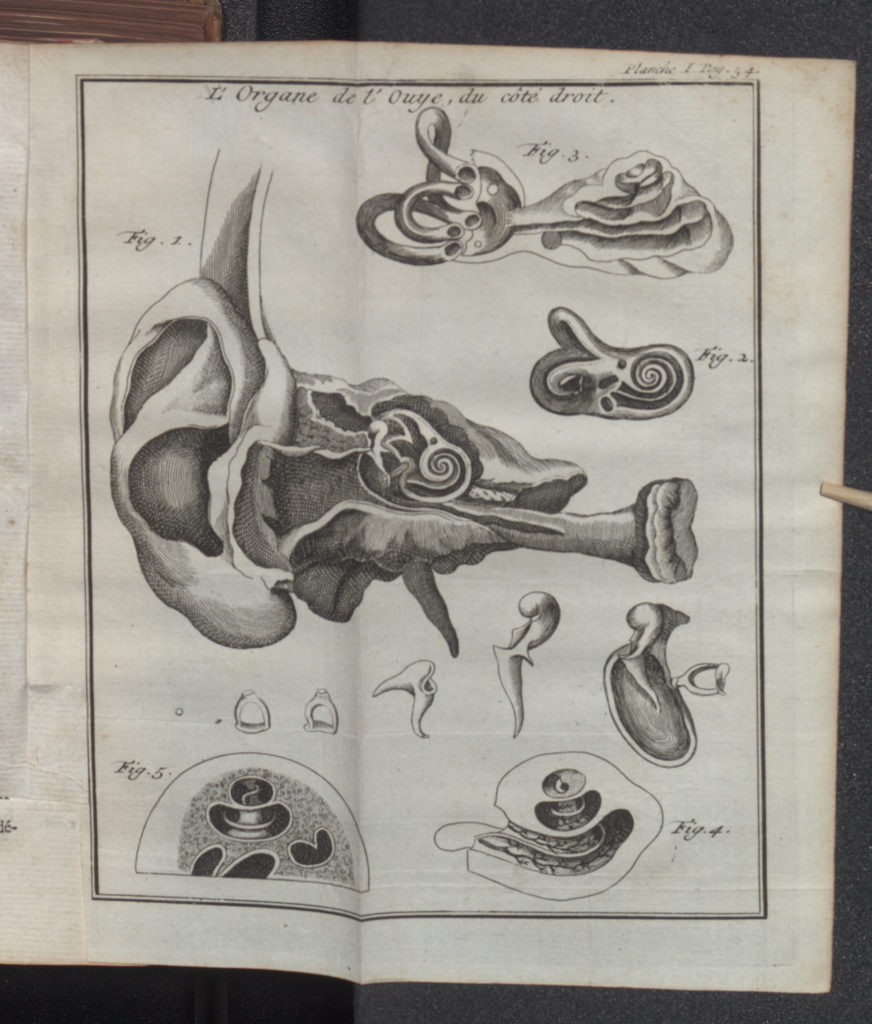
Claude-Nicolas Le Cat, “Planche I, L’Organe de l’ouse, du côté droit,” Traité des Sens, 1744. Image courtesy of the Yale Medical Historical Library
Given its unusual size, every part of the elephant’s body, from its sensory appendages to its internal organs, was intensely scrutinized. In The General History of China, Du Halde found elephants on the whole unappealing and “extremely ill-favoured, hav[ing] eyes like Hog.”[62] But in listing the different medicinal uses of their body parts, including flesh, bones, spleen, and eyes, he noted that the skin had miraculous, self-healing properties that might be used to close human wounds.[63] To audiences attuned to Le Cat’s science of sensation, the elephant’s magnified ear would confirm the civilizing virtue of auditory perception; the ear was a portal to a permeable, virtuously vulnerable body. At the same time, the elephant’s skin according to Du Halde promised corporeal defense and a protective, prosthetic coating for human use. The combined properties of permeability and impenetrability, or fragility and resistance, recall the fetishized contradictions of Chinese porcelain; it was a substance able to withstand terrifically high kiln heat, yet once finished, marvelously delicate and immanently breakable. China vases, for example, were often compared to White women’s bodies following the chauvinistic logic in the eighteenth century that female beauty, fidelity, and chastity were both fortified by social mores, and naturally prone to being flawed or shattered.[64]
While flora and fauna of natural history illustrations were abundantly used for porcelain decoration, ceramics also informed the understanding of animals’ bodies. In Denis Diderot and Jean le Rond d’Alembert’s Encyclopédie (1751–72), the author of the entry “Elephant,” Louis-Jean-Marie Daubenton, provided exact measurements of each body part. When it came to describing the elephant’s shapes, Daubenton employed ceramics metaphors. The trunk is shaped like a vase toward its end (“s’élargissoit comme le haut d’un vase”) and the tip resembles a cup (“tout le rebord formoit comme une petite tasse, au fond de laquelle étoient les narines”).[65] The corresponding plate illustrates this likeness and the upturned curve of the proboscis draws attention to the nostrils’ three openings (les narines).[66] The image bears a striking resemblance to the elephant trunks of Duplessis’s vases, and vice versa (fig. 10). Designed to hold candles, the porcelain nostril holes further underscore the function of animal ornament to link the senses of sight, smell, and touch, and to produce heightened sensory stimulation for the viewer.
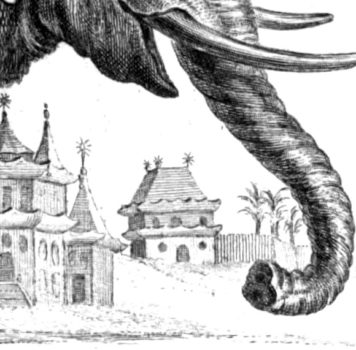
Fig. 10
Detail of Plate I in “Regne Animal/ Quadrupedes,” of Denis Diderot and Jean le Rond d’Alembert, Recueil de Planches sur Les sciences, les arts libéraux, et les arts méchaniques (London, 1768)
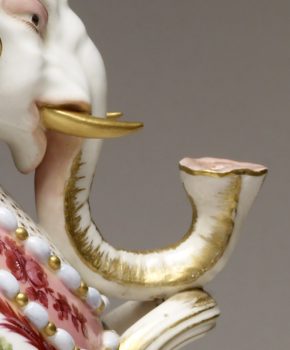
Detail of fig. 1
The Sèvres elephant heads were made according to the naturalistic design innovations of the porcelain industry, which resonated with mid-eighteenth-century studies of animal anatomy across Britain and France. Artists’ depictions of elephants, though still reliant on ancient and secondhand sources, drew increasingly on viewings of living creatures in court menageries and traveling exhibitions.[67] Of course, Europeans had observed Asian elephants in person since the 1500s: during this period at least thirteen young elephants accompanied by their mahouts were brought from India to cities across Europe, via Portugal, as royal gift exchanges.[68] An ardent patron of the Versailles menagerie, Louis XIV kept an elephant for thirteen years until its death in 1681, after which it was dissected.[69] While Louis XV paid less attention to the menagerie, he commemorated his love of hunting by commissioning a painting, Elephant Hunt (1736) by Charles Parrocel.[70] Court artists like Jean-Baptiste Oudry illustrated exotic animals after preserved corpses or live examples from the Versailles menagerie. As evidenced in his illustrations for La Fontaine’s Fables, re-published in the 1750s, Oudry specialized in animal expression and what Sarah Cohen has called a “Rococo ‘ecology’” that inserted naturalistic animals into a stylized environment or scene.[71]
The culture of exotic animal keeping inspired artistic renderings like the Sèvres elephants, as did some natural history accounts that extolled the elephant’s attributes. Comte de Buffon, Daubenton’s former manager at the botanical garden of Paris (Jardin des plantes), offered an extraordinary account of elephant anatomy and sensibility. Buffon’s Natural History portrayed the pachyderms not as hideous marvels of Hindu mythology or Eastern imperial hunts, but rather as beautifully ornamented, feminine paragons. In the East Indies, he wrote, elephants are crowned with garlands, have painted ears and cheeks, “delight in a golden harness or magnificent trappings,” and on festival days, are dressed with gold and silver rings around the tusks: “their harness is ornamented with little bells.”[72] The legs are compared to architectural pillars. The skin is meticulously cleaned by being rubbed with pumice stones, then perfumed, and painted much like ladies’ skin.[73]
Anatomical science in Buffon’s account affirmed elephants’ exquisite sensory organs, and their heightened powers of sensation made them the perfect embodiment of cross-cultural synesthesia. The elephant’s emotional and rational intelligence are evidenced by each of its distinctive parts, according to Buffon. Its eyes, though relatively small, display a “pathetic sentimental expression” that indicates its wishes and desires, and powers of deliberation. Its sense of hearing is superior to all other animals; it appreciates music to the point of dancing. The trunk miraculously unites multiple sensations: “the delicacy of feeling, exquisitiveness [sic] of smelling, facility of motion, and the power of suction.” Like Daubenton, Buffon describes the extremity of the trunk as having “the form of a cup.” It enables “a most exquisite sense of smelling, perhaps more perfect than that of any other animal,” to such an extent that the elephant “makes nosegays of [fragrant flowers], which he smells with eagerness, and then carries to his mouth, as if he intended to taste them.” (He has a predilection for orange flowers.) Furthermore, this “organ of sentiment” resembles a human finger. For Buffon, the sense of touch or feeling is “that which is the most analogical to knowledge,” and the elephant’s “multiplied sensations are equivalent to reflection.” Buffon argues that, if memory retention is most effective when multiple senses are combined, the elephant, of all, has the deepest repository of knowledge. In short, “the elephant is . . . a miracle of intelligence, and a monster of matter.”[74]
In the most stunning passage in Buffon’s text, the elephant is even praised—in racialized terms—for its moral virtue. The invocation of its Europeanized, feminized modesty sets Buffon’s elephant apart from Du Halde’s hog-eyed beast or Daubenton’s hunted behemoth. In Buffon’s broader racist scheme of nature’s hierarchies, the chaste female elephant differs from the orangutan or African women, both considered lascivious and prone to interspecies attraction.[75] The elephant bashfully refuses to copulate in public or in the presence of humans, and has sex in the missionary position, even in private. The male elephant, despite its great size and employment in battle, still eats in moderation. Though “fond of wine, spirituous liquors, brandy, and arrack,” he tempers his appetite out of a love of cleanliness. Due to their virtuous sensibilities, elephants have an innate love of freedom, and this sets them apart from other beasts: “he is not like these born slaves, which we train or multiply for our use. Here the individual alone is a slave, the species remains independent . . . This alone shews in the elephant elevated sentiments superior to the nature of common brutes.”[76] Exempt from slavery, Buffon’s elephant is not quite human, not quite animal. It is a product of tropical climates even as it appears to transcend its environs. It occupies the place of a foreign observer whose in-between status naturalizes, racializes, and genders the line between those destined for freedom and those “born” to slavery.
In one area, though, the “monster of matter” exhibited a form of racialized monstrosity—the “accidental” whiteness of white elephants.[77] The phenomenon of albinism, though not well understood, was a source of fascination for natural philosophers in the seventeenth and eighteenth centuries. Non-European whiteness, in people as well as animals, became a limit case for the science of racial difference. Lacking the language of hereditary genetics, Buffon attributed the white skin of albinos to degenerative accidents of nature that could be corrected over time. Across numerous natural histories and travel writings, non-European, albino whiteness was of a lesser and different order, which ultimately affirmed that white (European) color was the primordial and preferred complexion. As the eighteenth-century novelist and poet Oliver Goldsmith described albinism, “All those changes which the African, the Asiatic, or the American undergo are but accidental deformities, which a kinder climate, better nourishment, or more civilized manners, would, in a course of centuries, very probably, remove.”[78] On the one hand, the uncommonness of white elephants made them gentle outliers and icons of the East—as reported by one Father Vincent Marie, white elephants were “the largest, most gentle, and of the best temper,” and “worshipped as gods by several nations.”[79] On the other, their exceptionalism supported a growing consensus around a universal standard of whiteness as a sign of European virtue.
The existence of (false) white life forms outside Europe posed a challenge to theorists of racial difference concerned with the material source of skin color, particularly blackness. The field of scientists studying and even dissecting black skin had grown, horrifically, to the point that, in 1739, the Bordeaux Academy of Sciences solicited submissions for an essay competition on the cause of black skin and hair. Eighteenth-century anatomists formulated their theories of blackness in a new era of material science and proto-eugenics.[80] The Virginian Royal Society member John Mitchell held that the thickness of African skin when oiled blocked light transmission and usefully acted as a “coat to keep off the Power of the Sun, and preserve the Body against the Moisture of the Air.”[81] The Dutch anatomist Petrus Camper referred to African blood as “tints” comparable to mulberry sap. In considering the “mixture of people” that produced different skin tones, he also described the body as a mortar wherein mercury and sulphur were mixed to produce the skin’s black dye. Moreover, he described skin as “varnish” that preserved the sub-epidermal layers.[82] The combination of the anatomical gaze with artisanal metaphors produced a visualization of black and white bodies across species and media, and in relation to a world of fungible and finely wrought things.
As discussed above, Asian elephant sensitivity, including emotional and sensory intelligence, memory retention, and moral virtue, served to amplify the refinements of human perception from a White European male perspective. The wondrous properties of the elephant made its body a conceptual talisman, metaphorically, able to ward off slavishness and bestiality. That is, the investigative prowess demonstrated by knowing the elephant from all angles, inside and out, indexed Europeans’ sense of their epistemological ingenuity and the ability to tame a formidable Asian and African beast. Its parts merited anatomical study and meticulous artisanal replication, even if, as demonstrated by the Sèvres vases, in anthropomorphized form. Buffon’s cataloguing of the elephant offers a hypothetical template for the Sèvres elephant heads, down to their finely painted gold eyelashes. As Buffon points out, eyelashes are peculiar to men, monkeys, and elephants.[83] Even the balance of wild and tame attributes described by Buffon can be seen in Duplessis’s incorporation of the outsized elephant heads into the confined shape of the vases’ handles.
The elephantine, as rendered in porcelain, thus solicited a mixture of attraction and repulsion that was integral to the eighteenth-century fascination with highly sensitive, racialized surfaces, from human skin to sculptural glaze. Scientist-artists sought to perfect porcelain’s distinctive translucent whiteness and the colored enamels applied to its surface, at the same time that physicians and anatomists sought to understand human complexion. Critics have focused largely on blackness as a racializing quality, but we should keep in mind that whiteness was a constructed value as well. As Kim Hall has argued, “blackness [creates] a value for whiteness.”[84] Color was not only scrutinized, it was made. The scientific theories that materialized color developed in tandem with an aesthetics of racial difference that understood complexions (black and white) as the layering of substances that could be, and were, abstracted (and violently extracted) from their human and animal subjects.
Racializing the Four Continents, Animalizing Foreignness
Western decorative art has long associated the elephant—and the elephant’s head—with Africa, largely due to the precedent set by the Italian author Cesare Ripa in his influential emblem book, Iconologia (1603), first published without the woodcut illustrations in 1593. Listed as one of the allegorical Four Continents, Africa was personified as a female figure wearing an elephant headdress and holding a scorpion and bushel of wheat (fig. 11). According to Ripa, the elephant cap signaled “these animals being proper to Africa, used by these people in war not just as a marvel but first of all to scare the Romans, their enemies.”[85] In her study of Ripa’s numismatic sources, Joaneath Spicer has shown the close association of elephants with imperial conquests from Western antiquity. As imaged on classical coins, Alexander the Great wore an elephant headdress as a helmet—in imitation of the legend of Hercules donning the scalp of the Nemean lion—to celebrate the invasion of Egypt in 331 BCE, and of India four years later.[86] The coins of Octavian/Caesar Augustus (reigned 27 BCE‒14 CE) personified Africa wearing an elephant headdress, perhaps in acknowledgment of the reports from Greek historian Strabo of Mauritanians using elephant-skin shields in battle.[87] The elephant headdress continued to appear on the medals of the Roman emperors Septimius Severus (reigned 193–211 CE) and Hadrian (reigned 117–138 CE).
In the Renaissance and beyond, the elephant scalp headdress appeared widely in Baroque court art as an accoutrement of a personified Africa, together with icons of Asia, Europe, and America in the familiar grouping known as the Allegory of Four Continents. The countless renditions of the Four Continents in tapestry, atlases, prints, sculpture, and ceiling frescoes varied in design—sometimes Asia rides an elephant, as in Giambattista Tiepolo’s 1752 fresco at the Würzburg Residence in Germany—but generally each figure was imaged with its designated animal, plant, and object emblems.[88] Asia, for example, usually rides a camel and holds an incense vessel and scepter or golden crescent; Africa is pictured with a lion, red coral, and cornucopia, in addition to its distinct headdress.[89]
The use of color to further differentiate allegorical figures representing the continents prompts consideration of how ornamental colors developed alongside classifications of racial complexions in the eighteenth century. Even subtler depictions of skin color in a medium such as pastel painting still used tonal variations to distinguish between representations of the Four Continents in a manner that anticipated “racial pseudoscience.”[90] Artistic renditions sometimes depicted both Africa and America with feathered skirts or black skin color. The conflation of African and Amerindian representations in art, as well as literature, has been explained by a number of phenomena: the historical presence of enslaved Africans in the Americas, the replacement of Amerindians with African descendants as enslaved laborers, increased racial mixing, and the fact that the term “Indian” could refer to native inhabitants of the East and West Indies with darker complexions.[91] Blackness was not limited to the African continent. One of the early modern justifications for colonialism was the presence of “black” people the world over. Black populations could be found on all four continents, as the Spanish Jesuit Alonso de Sandoval asserted in his treatise on slavery published in 1627. His belief in the “potential whiteness of the black African soul” only underscored the Christian moral hierarchy of good and evil along a racialized color binary of white and black, which reinforced the developing system of Atlantic slavery.[92] As Sandoval wrote, “Our great King, who trades only in the Gospel, wants to acquire the most valuable pearls of the Orient and West: souls redeemed by his blood. These pearls come from the coarse and ugly shells of black and Indian bodies.”[93] Among the possible causes given for Asian blackness was a shared climate with Africa as dictated by latitude.[94]
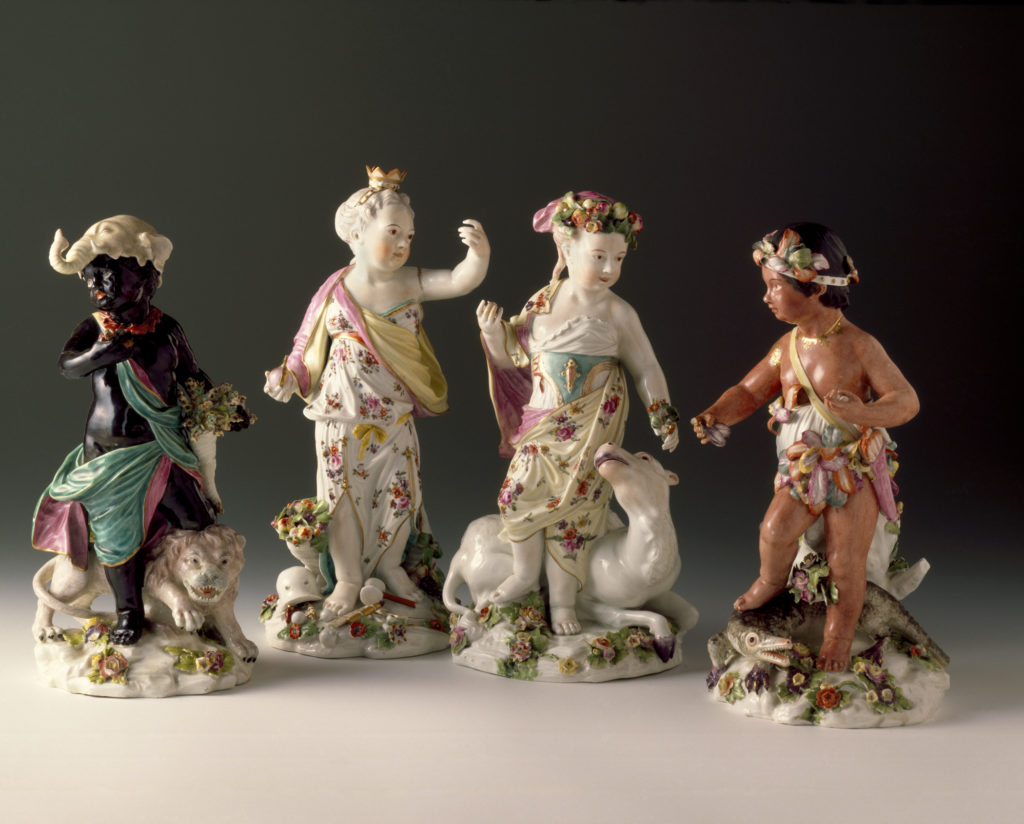
Derby Porcelain Works, The Four Quarters of the Globe, 1762–65, lead-glazed, soft-paste porcelain. Winterthur Museum, Bequest of Henry Francis du Pont, 1958.2622.001-.004
The allegorical affinity of Europe with Asia, though, was often established through the common whiteness, and even common gender, of their personified forms. By the mid-eighteenth century, European porcelain manufacturers, eager to establish their mastery of an Asian art form, turned to representing the four corners of the world in ceramic figurines. When modeled in clay, the figure of “Asia” is conjured doubly: as the allegorical representation of a continent, and through the material of translucent white porcelain, itself a Chinese-inspired marvel.[95] In one British soft-paste porcelain set at the Winterthur Museum, The Four Quarters of the Globe (ca. 1770), the continents are juvenile figures; Europe and Asia are rendered white and female, while Africa and America are androgynous, appearing further infantilized, and distinctly non-white (fig. 12). Although unusual, sometimes sets of continents mixed genders in this way.[96] The Chelsea/Derby manufacturers clearly used the occasion to showcase their color techniques by differentiating the shining jet-black glaze of Africa from a red-toned America, and both of these from the white glazes that unite Europe and Asia. It is worth noting a slighter tonal difference; the white enamel of Africa’s elephant hat contains more iron than the white bodies of Asia and Europe, which creates a white of a duller, lesser order—a bestial, second skin.[97] The animal ornament, in other words, at once humanizes and dehumanizes its wearer. The Winterthur set materializes two kinds of ornamental whiteness: the pallor of the elephant headdress, and the glossy white of imitation Chinese porcelain. Both work to “Africanize” Africa’s blackness, while also Europeanizing Asia’s perceived whiteness. Such is the black-white, color-coding effect of Meissen’s “Sultan Riding an Elephant” discussed earlier.
Porcelain workshops across Europe were eager to reproduce the sheen of Eastern hard-paste porcelain as well as to experiment with difficult glaze colors like white and black; innovations in color were integral to the novelty of the pieces. The contrast between black and white also took on racialized meaning through the transatlantic slave trade. As art historian Charmaine Nelson puts it, “the theme of the four continents was the allegorical performance of race itself.”[98] This allegorical structure of racial whiteness continues to delimit our ways of seeing. For one, an essentialist association of white with European identity makes it easy to misread the forms of artisanal whiteness. Take for example a Four Continents set made by the Meissen Porcelain Factory, which entwined a white figure of Asia (identifiable by the golden crescent of Islam in one hand) with a black figure of Africa: tellingly, Asia has been mislabeled “Europe,” an oversight probably due to the unwitting correlation of a black–white dichotomy with one that is African–European. This points to the larger issues of the figure of Asia being made to alternately disappear or stand in for Europe, and how Asian whiteness (metaphorical or material) functions as a racializing agent.
To expand on the idea of Asian whiteness, consider first its relation to another form of Asian blackness. If china in this period commonly connoted mass-produced translucence, fragility, and whiteness, japan suggested the ornate blackness, durability, and rarity of both Japanese and Chinese lacquer. In Britain, “japan” or “japanning” referred to Asian lacquer as well as European imitation lacquer and varnishing techniques.[99] Porcelain and lacquer were considered complementary collectors’ items due to their contrasting colors and luxuriant shine.[100] As the Parisian businessman, or marchand-mercier, Claude-François Julliot advertised in 1777, “Precious old Japanese lacquers are a perfect match for porcelains . . . connoisseurs consider these objects essential to the harmony of their collection.”[101] Dealers like Julliot profited from the incredible value of “Old Japan” lacquer pieces that had been imported from Asia a century earlier and were still in high demand. One of the most famous collectors, the gothic and Orientalist novelist William Beckford (1760‒1844), described himself as “affected with Japan-mania in a violent, incurable degree.”[102] In fact, he acquired many of the pieces from Madame de Pompadour’s lacquer collection (and even commissioned in 1792 a cabinet made of repurposed lacquer with elephant heads at the tops of its legs).[103]
From ceramics to statuary, finely wrought ornaments not only furnished luxurious interiors according to the dictates of taste and sensibility; chinoiserie innovations also used color and materials artistically to represent racial difference, as per the phenomenon of “ornamental blackness” identified by Adrienne L. Childs in her important study of decorative porcelain sculptures of enslaved Africans. Characterizations of “blackamoors,” often depicted wearing turbans, referenced both Africa and Asia, “essentially filtering the black African through the veil of an imagined Orient.”[104] From the sixteenth through the eighteenth centuries, “moor” or “blackamoor” referred generically to dark-skinned people—Africans, Ottomans, and Muslims of Berber and Arab descent, as well as the Black laborers of the Atlantic world. The concept of ornamental blackness could also be applied to black Asians if we look to Chinese and Japanese depictions of dark-skinned Indian disciples of Buddhas, or arhats, which took the form of lacquered bronze figurines in French decorative art.[105]
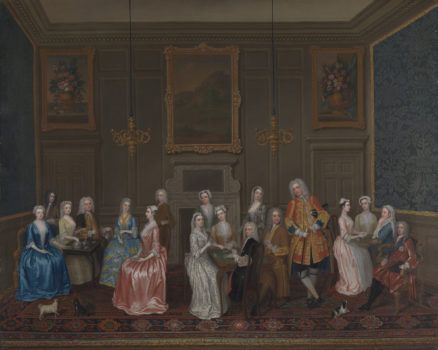
Fig. 13
Charles Phillips, Tea Party at Lord Harrington’s House, St. James’s, 1730, oil on canvas. Yale Center for British Art, Paul Mellon Collection, B1981.25.503

Detail
The racialized associations of lacquer and porcelain were evident across the eighteenth century. East Asian porcelain became an idealized form of white matter—an ornamental whiteness—that, like the white substance of Caribbean sugar, was at once difficult to refine and highly prized by consumers. British women continued the early modern practice of whitening their skin using the toxic lead substance ceruse, perhaps in an effort to match their hands with the whiteness of their chinaware (fig. 13).[106] This standard of aesthetic purity is suggested by numerous portraits of women with alabaster hands posed next to their gleaming white tea services. Referencing this trend, the potter Josiah Wedgwood, after designing a line of black basalt wares, wrote to his friend Thomas Bentley in 1772, “I hope white hands will continue in fashion & then we may continue to make black Teapots.”[107]
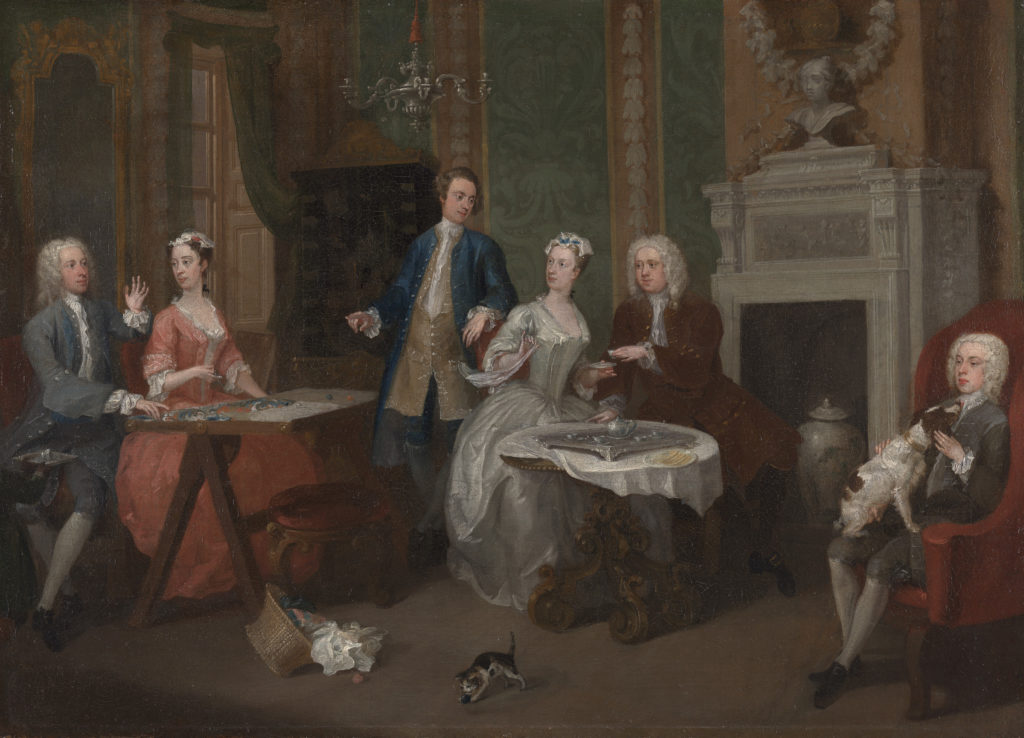
William Hogarth, Portrait of a Family, ca. 1735, oil on canvas. Yale Center for British Art, Paul Mellon Collection, B1977.14.58
To further accentuate their white faces and hands, women also employed servants with darker complexions. In a painting like William Hogarth’s Portrait of a Family (ca. 1735) (fig. 14), this “aesthetics of mastery” is evident in the interaction of black and white bodies.[108] The human subjects’ appearances are coded according to the colors of the Asian commodities that populate the drawing room. Porcelain structures the scene in a number of ways: teacups connect the seated figures and establish their intimacy, a glistening jar with lid sits upright in the fireplace at a remove, much like the disinterested boy in the red chair. Like other paintings of this period, Hogarth showcases the fashionability of Qing dynasty blue-and-white porcelain. The extent to which the people fashion themselves after the products they consume can be seen in the complementary blue and white outfits of the standing man and seated woman, whose porcelain-like complexion mirrors the whiteness of her chinaware.[109]
As components of sumptuous European interiors, Asian objects created new tastes for the exotic. Black lacquer and white porcelain were grounds for expression and innovation. They ornamented representations of enslavers’ and enslaved peoples’ bodies, and aestheticized depictions of Black labor. In Hogarth’s painting, a Japanese black lacquer cabinet on a gilt stand in the background contrasts in its blackness with the central whiteness of the woman, tea set, and tablecloth. Just in front, the standing gentleman’s finger points to a Black servant who enters the room at the painting’s bottom left. At some point the servant was nearly cropped out of the painting, perhaps for framing purposes. The act of dismemberment leaves him barely visible, but for the outstretched dark hands that hold a silver tray with a glistening, overturned teacup. In signaling the subtle disarray of the room, his partial presence still guides the action of the scene. He faces the black lacquer cabinet across the room, which matches the blackness of his skin tone and thus forms a diagonal in the painting’s composition. Although relegated to the background and the margins, these dark figures nonetheless stand in silent witness to the process of things and people fashioning each other.[110]
In the paintings and sculptures discussed above, racial ornamentalism adds value to a scene by linking different orders of representation—animate and inanimate—through a shared color regime. When returning our gaze to the Chinese figures and truncated elephants of the Sèvres vases, the overabundance of color and wondrous rococo detail belies a disappearance at the heart of the liveliness. What bodies are seen in place of those erased, or cut off, like Hogarth’s cropped Black servant? As discussed above, the allegorical investments in elephant corporeality persisted through the anatomical inquiries of Enlightenment racial science. Informed by the decorative tradition of the Four Continents, the elephant vases’ decapitated heads are toy trophies of bygone imperial aspirations, recalling emblematic African weapons when ridden into battle, representational scalp hats worn by Western conquerors as spoils of war, and finally, the decorative headdress of a figurative, black icon of Africa.
Yet, if the Sèvres elephant heads are a vestige of allegories of the Four Continents, the elephant heads’ resignification into chinoiserie spectacle both reintroduces the allegorical figures’ fleshly presence and registers the absence of African, and partial disappearance of Asian, bodies. In place of an African wearer of elephant heads, we see an Asian body, of sorts. The soft-paste, taxidermied heads have been attached to a porcelain body that sports painted, ornamental Chinese figures. To my mind, there is a certain proto–science fiction at work in this virtuosic feat of Frankensteinian patchwork. The anthropomorphized elephant ears make inert decorative matter complicit with the processes of racializing representational surfaces and dehumanizing African, Asian, and American lives rendered ornamental.
At issue, then, is less what the elephant stands for, and instead, what it activates in the beholder. In the Sèvres vases, the elephant’s body parts (those present, and those absent) create a rupture in the workings of animal allegory—a space to explore the racializing function of animal and Asian icons, and to see the material metaphors of White toxicity, fragility, supremacy. Porcelain, a fundamentally domestic medium, is not exactly a monument to racist state violence, like the sculptures commemorating men and ideologies from Columbus to Rizzo that were taken down worldwide in the summer of racial justice uprisings of 2020. But luxury consumption was an accessory to the Atlantic slave trade; and Western capitalism, to a significant extent, was built upon the human trafficking and commercial exchanges of transatlantic slavery, in concert with the trade in Asian commodities. The chinoiserie excesses of the Sèvres elephant-head vases encourage us to comprehend monstrosities big and small—the parts of history that do not fit together neatly, the human and animal costs to artistic innovations in decorative media, the racialized palette of Asian whiteness that developed in tandem with animal Orientalism.
Coda: Elephantine Afterlives, Racial Horror
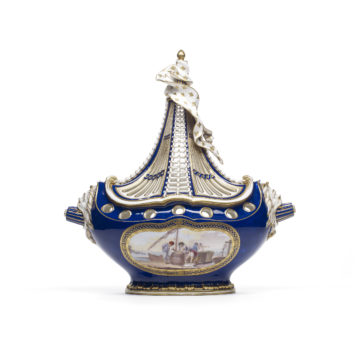
Fig. 15
Sèvres Porcelain Manufactory, Designer: Jean-Claude Duplessis La Père, Decorator: Jean-Louis Morin, Vase potpourri a vaisseau, 1764, soft-paste porcelain with enamels. The Walters Art Museum, Baltimore, Bequest of Henry Walters, 1931, acc. no. 48.559
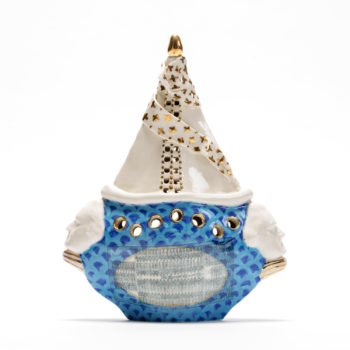
Roberto Lugo, Slave Ship Potpourri Boat, 2018, porcelain, china paint, luster. The Walters Art Museum, Baltimore, Museum purchase with funds provided by the W. Alton Jones Foundation Acquisition Fund, 2018, acc. no. 48.2882. © Roberto Lugo
This essay offers a cultural history of white elephant chinoiserie, which contributes to an understanding of the Walters’ elephant-head vases as eighteenth-century racial ornaments. Yet these enigmatic vases also invite viewers and artists to reimagine the past in new forms. The Philadelphia-based potter Roberto Lugo has reconceptualized Sèvres porcelain to uncover the ongoing monstrosities of racism and White privilege. Slave Ship Potpourri Boat (2018) is one instance that comments directly on the cross-sensory designs of porcelain garnitures that included vase-candelabras and incense holders like the Walters’ Sèvres boat-shaped potpourri vase, Vase pot-pourri à vaisseau, designed by Duplessis (fig. 15). In response to this object, Lugo remade the shape to force viewers to reckon with the horrors of the Middle Passage and its role in amassing European wealth. Reenvisioned as a miniature slave ship, Lugo’s vessel is adorned with a figurehead of George Washington on either end; painted onto its body is a replica of an engraving depicting prostrate Black bodies crammed into one space. Regarding the Sèvres potpourri vase Lugo remarked, “The boat depicts life at sea but it was also a functional vessel to give off a good scent. However, at the time that it was made, slave ships were carrying people and using scent as a form of torture.”[111]
Whereas the Sèvres vase once held dried flower petals, this potpourri vessel memorializes Black suffering. Lugo reproduces the now familiar abolitionist image from the Plymouth Committee, an engraving of the slave ship Brooks, Plan of an African Ship’s Lower Deck with Negroes in the Proportion of Only One to a Ton (1788). With chilling precision, the plate diagrammed slavers’ actuarial logic and practice of packing hundreds of enslaved Africans into a hellish cargo hold. In this way they hoped to maximize the space and the profits from violently transporting human beings to the colonies, to function at once as laborers and commodities. In her book on the enduring legacy of this “slave ship icon,” Cheryl Finley speculates on the reaction of the eighteenth-century Afro-British abolitionist Olaudah Equiano upon being shown the image for the first time: “So haunting in its graphic depiction, the plan of the slave ship must have seemed capable of psychically transporting Equiano back to that foundational moment in the swollen belly of the slave ship when he was born into an African diaspora.”[112] That artists like Lugo continue to return to this moment and repurpose the engraving is a testament to the power of its documentary representation.
How does ornamental porcelain enact such “psychic transport” to scenes of subjugation even when the bodies are not made visible? An unlikely site of cultural commentary on the matter of chinoiserie’s monstrous whiteness is Jordan Peele’s popular body-snatching horror film Get Out (2017). The film’s White, rich Armitage family lures African Americans to their secluded home, where they auction off the people and conduct surgical transplantations to allow White elites to live forever in beautiful Black bodies. While the family embodies what Charmaine Nelson has called “white collective narcissism . . . fueled by the racialization of vision and sensory perception,” I am interested in how the figure of the Asian mediates Black–White relations, and how chinoiserie ornament activates racial traumas and embodied resistance.[113] In one scene of bidding, that Anne Cheng has called a “sci-fi version of a slave auction,” there appears to be one person of color, a Japanese man (Yasuhiko Oyama) who bids on the Black protagonist Chris (Daniel Kaluuya) in heavily accented English.[114] The Asian man is a foreigner and a caricatured cultural intermediary, at once hypervisible and a mouthpiece for White supremacy—a twenty-first-century elephant in the room. His character seems to embody Asian economic might and the structures of global capitalism. In his person, Asian-ness becomes a proxy for neo-colonialism.[115]
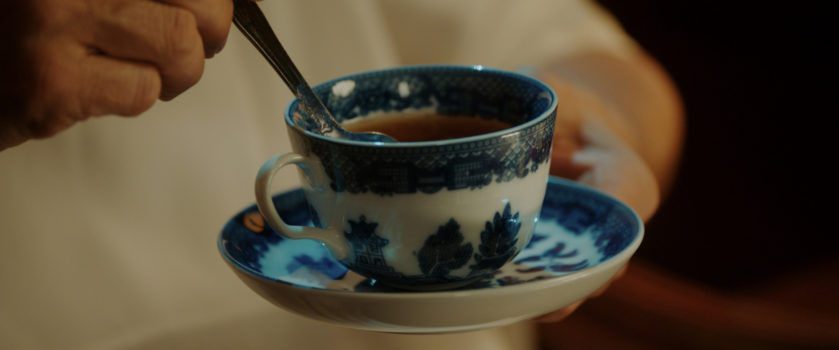
Fig. 16
(detail) Peele, Jordan, director. 2017. Get Out. © 2017 Universal City Studios Productions LLLP. Courtesy of Universal Studios Licensing LLC
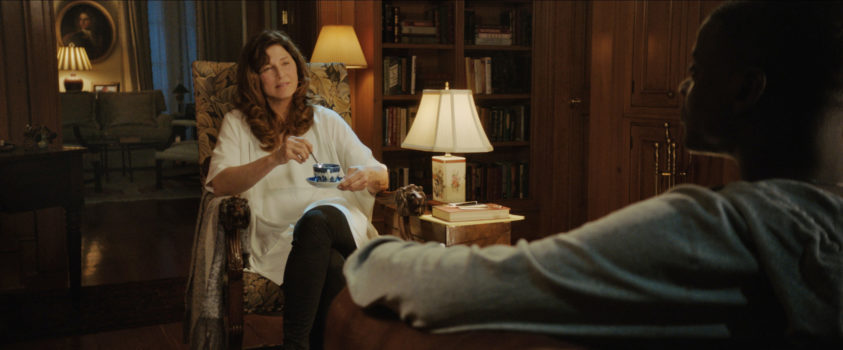
Peele, Jordan, director. 2017. Get Out. © 2017 Universal City Studios Productions LLLP. Courtesy of Universal Studios Licensing LLC
At the center of the film, though, is another Asian object that, in the hands of the demented mother-psychiatrist Mrs. Armitage (Catherine Keener), unleashes Chris’s psychic nightmare. A blue-and-white, willow-patterned porcelain teacup is the fixation object she uses to hypnotize the hapless Black protagonist seated across from her (fig. 16). The clinking of a silver spoon inside the delicate teacup stirs up personal and collective racial memories at the heart of the film. As she stirs the tea, her voice guides Chris deep into a traumatic childhood memory, and he is transported into a “sunken place” that resembles the darkness of a slave ship hold. The teacup, we realize, is an accouterment of a slave society that helped define racial Whiteness in an era of nascent capitalism and British empire, and continues to accessorize class- and race-based hierarchies in the present.
Like the eighteenth-century ladies portrayed with their china, the White women of the Armitage family are linked to beverages, whether through the mother’s white teacup or the cool glass of milk drunk by the daughter, Rose (Allison Williams), as she searches online for her next Black boyfriend and victim. Just as the daughter-girlfriend has penetrated Chris’s body, the mother has penetrated his mind. The teacup is nowhere near as grotesque as the milk glass, but both are white objects that racialize mother and daughter alike. At once a plot device, controller of character, and instrument of mise-en-scène, the teacup is not only seen, it is heard. It is one of the sounds of horror that propel the film, whether through the clinking of the mother’s hypnotic silver spoon or the shattering of the porcelain when Chris prevails. Each piece of white matter reactivates the multisensory experience of racial horror. Like the ear of the elephant, the teacup is a chinoiserie portal into material histories of whiteness and the cyclical productions of monstrous matter.
Special thanks to Ruth Bowler, E.R. Cho, Ellie Hughes, Jerry Miller, Iris Moon, Laura Seitter, and Yao-Fen You.
[1] The two elephant vases were later placed atop a commode along with two other Sèvres vases in the bedchamber of Bourbon’s daughter-in-law, the Duchess of Bourbon, Louise-Marie-Thérèse-Bathilde d’Orléans, at the family residence in Paris. See Marie-Laure de Rochebrune, “Paire de vases ‘à oreilles’ en première grandeur, à fond rose,” in Nouvelles acquisitions du département des objets d’art (1995–2002), exh. cat., Musée du Louvre (Paris: Réunion des Musées Nationaux, 2003): 134–37. For a brilliant study of the history of the Met’s elephant-vases in the late eighteenth-century context of the institutionalization of the Louvre Museum, see Iris Moon, “The Sèvres Elephant Garniture and the Politics of Dispersal during the French Revolution,” forthcoming in the Metropolitan Museum Journal.
[2] Louis XV also purchased three pairs of the elephant-head vases. Twenty-two of these vases are thought to have survived, and ten of the potpourri vessels. Daniëlle Kisluk-Grosheide and Jeffrey Munger, The Wrightsman Galleries for French Decorative Arts, The Metropolitan Museum of Art (New Haven, CT: Metropolitan Museum of Art and Yale University Press, 2010), 195–96.
[3] Of the twenty-five pieces made with Chinese designs, Pompadour purchased fourteen. There is one documented case of a pink garniture of five pieces with chinoiserie designs that she placed in her bedchamber in the palace Hôtel d’Évreux in Paris. Marie-Laure de Rochebrune, “La passion de madame de Pompadour pour la porcelaine,” in Madame de Pompadour et les arts, ed. Xavier Salmon, exh. cat., Musée national des château de Versailles et de Trianon (Paris: Réunion des Musées Nationaux, 2002), 443–44.
[4] See Mimi Hellman’s discussion of seriality of furnishings that produces an “aesthetics of surplus” as well as an “anxiety of seriality.” “The Joy of Sets: The Uses of Seriality in the French Interior,” in Furnishing the Eighteenth Century: What Furniture Can Tell Us about the European and American Past, ed. Dena Goodman and Kathryn Norberg (New York: Routledge, 2007), 147, 149.
[5] Kristel Smentek, “Global Circulations, Local Transformations: Objects and Cultural Encounter in the Eighteenth Century,” in Qing Encounters: Artistic Exchanges between China and the West, ed. Petra ten-Doesschate Chu and Ning Ding (Los Angeles: Getty Research Institute, 2015), 49.
[6] Jeffrey Munger, European Porcelain in The Metropolitan Museum of Art (New York: Metropolitan Museum of Art, 2018), 190. See Janet Gleeson, The Arcanum: The Extraordinary True Story of the Invention of European Porcelain (London: Bantam Press, 1998), 177. Note that the British did not make hard-paste porcelain until 1768.
[7] See Maureen Cassidy-Geiger, “Of Elephants and Porcelain,” The French Porcelain Society Journal 1 (2003): 113–30, and also Rosalind Savill, The Wallace Collection: Catalogue of Sèvres Porcelain (London: Trustees of the Wallace Collection, 1988).
[8] Maxine Berg, “Asian Luxuries and the Making of the European Consumer Revolution,” in Luxury in the Eighteenth Century: Debates, Desires, and Delectable Goods, ed. Maxine Berg and Elizabeth Eger (New York: Palgrave, 2003); Robert Finlay, The Pilgrim Art: Cultures of Porcelain in World History (Berkeley: University of California Press, 2010); Kenneth Pomeranz, The Great Divergence: China, Europe, and the Making of the Modern World Economy (Princeton, NJ: Princeton University Press, 2000).
[9] Marie Laure de Rochebrune, “Charles Nicolas Dodin, miniature painter at Vincennes-Sèvres,” The Magazine Antiques 158, no. 4 (October 2000): 527; Carl Christian Dauterman, “Chinoiserie Motifs and Sèvres: Some Fresh Evidence,” Apollo 84 (December 1966): 476, 477.
[10] Dauterman, 478.
[11] The Daoist Immortal Cao Guojiu, imaged on Chinese porcelain, is often pictured dancing with castanets, which serve to purify his surroundings. While Chinese castanets tend to be elongated sticks, the round shape of European castanets approximates the objects in the Dodin scene.
[12] The museum’s label is widely cited. See Amy Henderson, “Cataloguing the Eighteenth-Century French Porcelain Collection of the Walters Art Museum,” The Journal of the Walters Art Museum 60/61 (2002/2003): 66. Dauterman also identifies Boucher’s Hearing as Dodin’s source “without a doubt.” See Dauterman, “Chinoiserie Motifs,” 478.
[13] The instruments look more European than Asian, though they seem to combine elements of both traditions. The bells, for example, resemble Western church bells instead of Chinese bronze bianzhong. The cymbals differ from Chinese gongs, and the mallets look like those for a xylophone or marimba. The Greek lyre is comparable to a Chinese ruan or yuqin, round in shape; the small European lute could perhaps reference a Chinese sanxian or pipa. Thanks to Shelley Zhang for these insights. Other evidence for mixing European with Asian imagery is in Boucher’s Taste, where the melon featured could reference either a French cantaloupe (Cavaillon melon) or Chinese watermelon.
[14] As for the woman-infant pair, Richard E. Strassberg has traced them to the Chinese print Ermian (Second Molting) in Jiao Bingzhen, Yuzhi gengzhi tu (Beijing: Wuyingdian, 1696), plate 25. Strassberg, “War and Peace: Four Intercultural Landscapes,” in China on Paper: European and Chinese works from the Late Sixteenth to the Early Nineteenth Century, ed. Marcia Reed and Paola Demattè (Los Angeles: Getty Research Institute, 2011), 90–93.
[15] This Berlin Porcelain Factory set features Boucher’s Touch, Smell, Hearing, and Sight. Thanks to Yao-Fen You and the Cooper Hewitt Decorative Arts department.
[16] See Robert Boyle, Experiments and considerations touching colours (London, 1664) and the satirical account of touching and smelling color in Jonathan Swift, Gulliver’s Travels (Peterborough, ON: Broadview Editions, 2012), 233. See also William Hogarth, The Analysis of Beauty, ed. Ronald Paulson (New Haven: Yale University Press, 1997).
[17] Adrienne Ward, Pagodas in Play: China on the Eighteenth-Century Italian Opera Stage (Lewisburg, PA: Bucknell University Press, 2010).
[18] Sarah Cohen and Downing A. Thomas, “Art and the Senses: Experiencing the Arts in the Age of Sensibility,” in A Cultural History of the Senses: In the Age of Enlightenment, ed. Anne C. Vila, vol. 4 (London: Bloomsbury, 2014), 183. Dauterman, 480.
[19] See, for example, the designs of corporal punishment in John Stalker and George Parker, Treatise of Japanning (London, 1688), and the continuation of this theme in George H. Mason, The Punishments of China (London, 1801).
[20] Eric Hayot, The Hypothetical Mandarin: Sympathy, Modernity, and Chinese Pain (Oxford: Oxford University Press, 2009), 28, 96.
[21] Another good example of allegorical Chinese figures is Jean-Baptiste Pillement’s series representing the twelve months of the year, etched with engravings by Pierre-Charles Canot (1710–1777) in 1759. See Maria Gordon-Smith, “The Influence of Jean Pillement on French and English Decorative Arts. Part One,” Artibus et Historiae 21, no. 41 (2000): 171–96. And “Part Two,” Artibus et Historiae 21, no. 42 (2000): 119–63.
[22] Edmund Burke, Philosophical Inquiry into the Origin of Our Ideas of the Sublime and Beautiful, ed. Adam Phillips (Oxford and New York: Oxford University Press, 1990). Burke’s text was first published in 1757.
[23] Claude-Nicolas Le Cat, A physical essay on the senses. Translated from the French (London, 1750), 9, Eighteenth Century Collections Online (ECCO), Gale document number CW3307300127.
[24] For the Romantic discussions of symbol and allegory, including Schelling’s theory that “[m]usic is an allegorizing art, painting schematizes, the plastic arts are symbolic,” see F. W. J. Schelling, The Philosophy of Art, trans. Douglas W. Stott (Minneapolis: University of Minnesota Press, 1989), 48. Schelling’s Die Philosophie der Kunst was first published in 1859. See also Nicholas Halmi, The Genealogy of the Romantic Symbol (New York: Oxford University Press, 2007). For other accounts that prioritize symbol over allegory, see Samuel T. Coleridge, Lay Sermons, ed. R. J. White (London: Routledge & K. Paul, 1972).
[25] William Chambers, A Dissertation on Oriental Gardening (Dublin, 1773), 50, ECCO, Gale document number CW3315440113.
[26] Jonathan Hay, Sensuous Surfaces: The Decorative Object in Early Modern China (London: Reaktion Books, 2010), 81.
[27] Richard Graves, “On Mrs. C—R—Y’s Villa, at Hampstead, 1760,” in Euphrosyne: or, Amusements on the Road of Life (London, 1776), 124, ECCO, Gale document number CW3315657514.
[28] From “What is good taste?” Published text of Associated TV Broadcast, December 1, 1958. Quoted in Rosalind Savill, The Wallace Collection: Catalogue of Sèvres Porcelain (London: Trustees of the Wallace Collection, 1988), vol. 1: 162, 43n.
[29] Eugenia Zuroski Jenkins, A Taste for China: English Subjectivity and the Prehistory of Orientalism (New York: Oxford University Press, 2013), 63. David Porter, The Chinese Taste in Eighteenth-Century England (Cambridge: Cambridge University Press, 2010), 3.
[30] David Porter, Ideographia: The Chinese Cipher in Early Modern Europe (Stanford, CA: Stanford University Press, 2001), 196. See also Porter, “Monstrous Beauty: Eighteenth-Century Fashion and the Aesthetics of the Chinese Taste,” Eighteenth-Century Studies 35, no. 3 (Spring 2002): 395–411, www.jstor.org/stable/30054206.
[31] Ephraim Chambers, Cyclopaedia, or an Universal Dictionary of Arts and Sciences, vol. 2 (London, 1728), 573, ECCO, Gale document number CW3306297715.
[32] In this instance, Buffon refers to a bat as half bird, half quadruped. Georges-Louis Leclerc, Comte de Buffon, Barr’s Buffon. Buffon’s Natural history containing a theory of the earth, a general history of man, of the brute creation, and of vegetables [. . .], 10 vols. (London, 1792), 6:240, ECCO, Gale document number CW107327418.
[33] John Hill, Exotic botany illustrated [. . .] (London, 1759), 8.
[34] Walpole to Bentley, July 5, 1755, in The Yale Edition of Horace Walpole’s Correspondence, ed., W. S. Lewis, vol. 35 (New Haven, CT: Yale University Press, 1973), 233.
[35] John Shebbeare, Letters on the English nation: by Batista Angeloni, a Jesuit, who resided many years in London, vol. 2 (London, 1755), 261–62, ECCO, Gale document number CW3305076526.
[36] A collection of modern fables ([London?], 1771), 160, ECCO, Gale document number CW3324543212.
[37] William Chambers, Designs for Chinese Buildings, Furniture, Dresses, Machines, and Utensils (London, 1757), 15.
[38] In animal husbandry, as well, the importation of Chinese pigs transformed English breeds. Sam White, “From Globalized Pig Breeds to Capitalist Pigs: A Study in Animal Cultures and Evolutionary History,” Environmental History 16, no. 1 (January 2011): 94–120, https://doi.org/10.1093/envhis/emq143.
[39] George Colman, The Connoisseur, October 8, 1754, 536, ECCO, Gale document number CW3317196980.
[40] Shebbeare, Letters, 261. See also Marie-Hélène Huet, Monstrous Imagination (Cambridge, MA: Harvard University Press, 1993).
[41] Augustus II had built the first successful Western porcelain factory in 1709 near Dresden, at Meissen; his porcelain zoo was never completed but his modeler Johann Joachim Kaendler did complete five hundred works before the project was discontinued by 1740. Samuel Wittwer, The Gallery of Meissen Animals: Augustus the Strong’s Menagerie for the Japanese Palace in Dresden (Chicago: University of Chicago Press, 2004).
[42] Anne Anlin Cheng, Ornamentalism (New York: Oxford University Press, 2019), ix.
[43] Edward Said, Orientalism (New York: Vintage, 1979), 10; Cheng, Ornamentalism, 24, 18.
[44] Jonathan Hay, Sensuous Surfaces.
[45] Stacey Sloboda, Chinoiserie: Commerce and Critical Ornament in Eighteenth-Century Britain (Manchester: Manchester University Press, 2014), 9, 3. See also Sloboda, “Surface Contact, Decoration in the Chinese Taste,” in Qing Encounters: Artistic Exchanges between China and the West, ed. Petra ten-Doesschate Chu and Ning Ding (Los Angeles: Getty Research Institute, 2015): 248–63.
[46] The slipperiness between the ornamental and the oriental was acknowledged already in the late eighteenth century by Horace Walpole, who lambasted the Asia-mania of the moment. In his comparison of works by his contemporaries William Chambers and William Jones, he punned, “[although Chambers’s book] was advertised by the title of ornamental gardening, instead of oriental, I think Mr Jones’s is a blunder of oriental for ornamental, for it is very flowery, and not at all Eastern.” Walpole refers to William Chambers, Dissertation on Oriental Gardening (Dublin, 1773) and William Jones, Poems, Consisting Chiefly of Translations from the Asiatick Languages. Walpole to Mason, May 25, 1772, in The Yale Edition of Horace Walpole’s Correspondence, ed. W. S Lewis, vol. 28 (New Haven, CT: Yale University Press, 1955), 35–36.
[47] Chambers, Chinese Buildings, 15–16; Marc-Antoine Laugier, An Essay on the Study and Practice of Architecture (London, 1756), 264, ECCO, Gale document number CW3307947073 (my emphasis).
[48] Katie Scott, “Playing Games with Otherness: Watteau’s Chinese Cabinet at the Château de la Muette,” Journal of the Warburg and Courtauld Institutes 66 (2003): 210, 191.
[49] Partha Mitter, Much Maligned Monsters: History of European Reactions to Indian Art (Oxford: Clarendon Press, 1977).
[50] Chi-ming Yang, Performing China: Virtue, Commerce, and Orientalism in Eighteenth-Century England, 1660–1760 (Baltimore: Johns Hopkins University Press, 2011).
[51] Vincenzo Cartari, Imagini delli dei de gl’antichi (Venice, 1660), 377.
[52] Partha Mitter identifies two sources for the image: a 1553 Jesuit report on Shiva as viewed in a temple, and a 1560 sighting of Ganesha in Goa. Mitter, Much Maligned Monsters, 28–29.
[53] The elephant-head boy appears in other books on monsters, including Ulisse Aldrovandti, Monstrorum Historia (1642) and Fortuno Liceti, De Monstrorum Caussis, Natura, et Differentiis Libri Duo (1634). Others included a humanoid with an elephant proboscis known as the Monster of Krakow. See Ambroise Paré, Des monstres et prodigies (1573); Pierre Boaistuau, Histoire Prodigieuses (1560); Sebastian Münster, Cosmographia (1544).
[54] On the rhinoceros first imaged by Albrecht Dürer in 1515 and reproduced in countless books, see Brian Cumming, “Pliny’s Literate Elephant and the Idea of Animal Language in Renaissance Thought,” in Renaissance Beasts: Of Animals, Humans, and Other Wonderful Creatures, ed. Erica Fudge (Champaign, IL: University of Illinois Press, 2004), 164–85. For example, Johann Gottlieb Kirchner of the Meissen factory modeled an elephant and rhinoceros standing. See Samuel Wittwer, A Royal Menagerie: Meissen Porcelain Animals (Los Angeles: Getty Publications, 2001), 33.
[55] Guy Tachard, A relation of the voyage to Siam (London, 1688), 208, 213, 214, 215. Tachard was sent to Siam first in 1685 and subsequently made two visits.
[56] Nieuhof’s frontispiece to Embassy to China served as the source material for a scene in a sumptuous chinoiserie tapestry from Beauvais, “The Audience of the Emperor,” one of a six-part series, The Story of the Emperor of China. The Audience of the Emperor, 1722–23, from the series The Story of the Emperor of China, designed by Jean-Baptiste Monnoyer, ca. 1685–90, produced 1685–1740. See Charissa Bremer-David, Conundrum: Puzzles in the Grotesques Tapestry Series (Los Angeles: Getty Publications, 2015), 20. See also Edith A. Standen, “The Story of the Emperor of China: A Beauvais Tapestry Series,” Metropolitan Museum Journal 11 (1976): 103–17.
[57] Jean-Baptiste du Halde, The General History of China, vol. 4 (London, 1736): 28, ECCO, Gale document number CW3300360204.
[58] Le Cat, 43.
[59] Penelope Gouk and Ingrid Sykes, “Hearing Science in Mid-Eighteenth-Century Britain and France,” Journal of the History of Medicine and Allied Sciences 66, no. 4 (October 2011): 516, https://doi.org/10.1093/jhmas/jrq045.
[60] Ibid, 514.
[61] On Condillac’s Traité des sensations (1754), see Rowan Rose Boyson, “The Senses in Literature: Pleasures of Imagining in Poetry and Prose,” in Cultural History of the Senses, 168; see also Cohen and Thomas, 185.
[62] Du Halde, 28.
[63] Du Halde, 30.
[64] See, for example, John Gay’s poem, “To a Lady on Her Passion for Old China” (1725).
[65] Denis Diderot and Jean le Rond d’Alembert, eds., Encyclopédie, ou dictionnaire raisonné des sciences, des arts et des métiers, etc., 499. University of Chicago: ARTFL Encyclopédie Project (Autumn 2017 Edition), ed. Robert Morrissey and Glenn Roe, http://encyclopedie.uchicago.edu/.
[66] Plate I in “Regne Animal/ Quadrupedes,” of Recueil de Planches sur Les sciences, les arts libéraux, et les arts méchaniques, 3, https://artflsrv03.uchicago.edu/images/encyclopedie/V23/34.50percent.png.
[67] Christopher Plumb, “‘Strange and Wonderful’: Encountering the Elephant in Britain, 1675–1830,” Journal for Eighteenth-Century Studies 33, no. 4 (2010): 525–43, https://doi.org/10.1111/j.1754-0208.2010.00321.x.
[68] Donald Lach, “Asian Elephants in Renaissance Europe,” Journal of Asian History 1, no. 2 (1967): 134.
[69] Marina Belozerskaya, “Menageries as Princely Necessities and Mirrors of Their Times,” in Oudry’s Painted Menagerie: Portraits of Exotic Animals in Eighteenth-Century Europe, ed. Mary Morton, exh. cat. (Los Angeles: J. Paul Getty Trust, 2007): 70; Louise E. Robbins, Elephant Slaves and Pampered Parrots: Exotic Animals in Eighteenth-Century Paris (Baltimore: Johns Hopkins University Press, 2002), 46.
[70] The painting was designed after fifteenth-century engravings by Jan van der Straet. See F. Hamilton Hazlehurst, “The Wild Beasts Pursued: The Petite Galerie of Louis XV at Versailles,” The Art Bulletin 66, no. 2 (June 1984): 224–36.
[71] Sarah R. Cohen, “Animal Performance in Oudry’s Illustrations to the Fables of La Fontaine,” Studies in Eighteenth-Century Culture 39 (2010): 44.
[72] Buffon, Barr’s Buffon, 7:272, 276. See also Anita Guerrini, “Perrault, Buffon and the Natural History of Animals,” Notes and Records of the Royal Society of London (December 20, 2012): 393–409.
[73] Buffon, 7:299.
[74] Buffon, 7:286, 289, 288, 263, 286, 288, 289, 291 (my emphasis).
[75] Buffon describes the “compulsory or voluntary intermixture of the negresses with the apes,” Barr’s Buffon, 9:137. See also Laura Brown’s discussion of interspecies sexual encounters imagined between apes and African women, Fables of Modernity: Literature and Culture in the English Eighteenth Century (Ithaca: Cornell University Press, 2001), 236-238. The most outspoken proponent of this racist formulation was Edward Long, The History of Jamaica. Reflections on Its Situation, Settlements, Inhabitants, Climate, Products, Commerce, Laws and Government (1774).
[76] Buffon, 7:295, 306, 267.
[77] Buffon, 7:283.
[78] Oliver Goldsmith, An history of the earth, and animated nature (London, 1779), 2:242. Goldsmith’s discussion of albino “white Negroes,” cited the case of African or American infants born fair and darkening over time to argue for the superiority of white skin, a “transparent covering to the soul.” 240–42, 232. ECCO, Gale document number CW3308527885. See also Andrew Curran, The Anatomy of Blackness: Science & Slavery in an Age of Enlightenment (Baltimore: Johns Hopkins University Press, 2011).
[79] Buffon, 7:284.
[80] Pierre Barrère, Dissertation sur la cause physique de la couleur des nègres, de la qualité de leurs cheveux, et de la dégénération de l’un et de l’autre (Paris, 1741); Claude-Nicolas Le Cat, Traité de la couleur de la peau humaine en général, de celle des nègres en particulier (Amsterdam, 1765); Petrus Camper, “On the Origin and Color of Blacks” [in Dutch] (lecture, University of Groningen, November 14, 1764). See also Miriam Meijer, Race and Aesthetics in the Anthropology of Petrus Camper (1722–1789) (Amsterdam: Rodopi, 1999).
[81] John Mitchell, “An Essay upon the Causes of the Different Colours of People in Different Climates,” Philosophical Transactions of the Royal Society of London 43, no. 474 (January 1, 1744), 143, https://doi.org/10.1098/rstl.1744.0033. See also James Delbourgo, “The Newtonian Slave body: Racial Enlightenment in the Atlantic World,” Atlantic Studies 9, no. 2 (2012): 185–207.
[82] Meijer, Race and Aesthetics, 186, 190.
[83] Buffon, 301.
[84] Kim F. Hall, Things of Darkness: Economies of Race and Gender in Early Modern England (Ithaca, NY: Cornell University Press, 1995), 742.
[85] Cesare Ripa, Iconologia di Cesare Ripa (Siena, 1613), as translated by and quoted in Joaneath Spicer, “The Personification of Africa with an Elephant-Head Crest in Cesare Ripa’s Iconologia (1603),” in Personification: Embodying Meaning and Emotion, ed. Walter S. Melion and Bart Ramakers (Leiden and Boston: Brill, 2016), 680.
[86] Spicer, “Personification of Africa,” 701, 707–8. Spicer includes a remarkable example of a sixteenth-century drawing of a Moorish African in the role of a Titan, or Son of Atlas, for a Florence masque. The Florentine Alessandro Allori designed as part of the costume a head cap that sports two elephant heads. (Their placement on either side of the head uncannily resembles the design of the Sèvres vases.) Spicer, 694. See also Frank L. Holt, Alexander the Great and the Mystery of the Elephant Medallions (Berkeley: University of California Press, 2003).
[87] Spicer, 701.
[88] See Max Weintraub, “Producing the Legible Body: Personification, the Beholder, and Tiepolo’s Würzburg Frescos,” in Personification, ed. Melion and Ramakers, 655–74.
[89] Along with Ripa, Flemish artists Maarten de Vos (1532‒1603) and Philips Galle (1537‒1612) helped popularize the representative animals and accoutrements of the Continents. Alex Zukas, “Class, Imperial Space, and Allegorical Figures of the Continents on Early-Modern World Maps,” Environment, Space, Place 10, no. 2 (Fall 2018): 34, 40.
[90] See Oliver Wunsch, “Rosalba Carriera’s Four Continents and the Commerce of Skin,” Journal18 Issue 10 1720 (Fall 2020), https://www.journal18.org/5218.
[91] David Bindman, “Introduction,” in The Image of the Black in Western Art, vol. 3, From the “Age of Discovery” to the Age of Abolition, Part 3: The Eighteenth Century. ed. David Bindman and Henry Louis Gates, Jr. (Cambridge, MA: Harvard University Press, 2011), 14. While some scholars caution against anachronistic readings of color-based race and racism, others argue for the historical continuity of racial constructions, even while acknowledging the instability of racial terminology in the early modern period and eighteenth century. See Roxann Wheeler, The Complexion of Race: Categories of Difference in Eighteenth-Century British Culture (Philadelphia: University of Pennsylvania, 2000); Ania Loomba and Jonathan Burton, Race in Early Modern England: A Documentary Companion (New York: Palgrave Macmillan, 2007); Cassander L. Smith, Black Africans in the English Imagination: English Narratives of the Early Atlantic World (Baton Rouge: Louisiana State University Press, 2016). On the figure of the Asian “indio,” see Tatiana Seijas, Asian Slaves in Colonial Mexico: From Chinos to Indians (New York: Cambridge University Press, 2014).
[92] Grace Harpster, “The Color of Salvation: The Materiality of Blackness in Alonso de Sandoval’s De instauranda Aethiopum salute,” in Envisioning Others: Race, Color, and the Visual in Iberia and Latin America (Leiden: Brill, 2015), 101.
[93] See Harpster, 109. The quotation is from Alonso de Sandoval, Treatise on Slavery: Selections from De instauranda Aethiopum salute, trans. and ed. Nicole von Germeten (Indianapolis: Hackett, 2008), 189.
[94] Alonso de Sandoval, Un Tratado sobre la esclavitud, trans. Enriqueta Vila Vilar (Madrid: Alianza Editorial, 1987). See Anna More, “Jesuit Networks and the Transatlantic Slave Trade: Alonso de Sandoval’s Naturaleza, policía Sagrada y profana (1627),” in Iberian Empires and the Roots of Globalization, ed. Ivonne del Valle, Anna More, and Rachel O’Toole (Nashville, TN: Vanderbilt University Press, 2020), 131–58.
[95] Benjamin Schmidt dates the personification of the Continents in the medium of porcelain to the Meissen factory figures made in the 1740s. Schmidt, “The Rearing Horse and the Kneeling Camel: Continental Ceramics and Europe’s Race to Modernity,” in Bodies and Maps, 334. In his haste to associate the allegorical figure of “Asia” with China and Chinese porcelain, though, he misidentifies the incense vessel held by the Meissen figure of Asia as a “porcelain teapot.” See Schmidt, 337, and the Metropolitan Museum of Art’s “Asia (one of a pair)” (ca. 1745‒55) https://www.metmuseum.org/art/collection/search/236776.
[96] See Michael Wintle, “Gender and Race in the Personification of the Continents in the Early Modern Period: Building Eurocentrism,” in Bodies and Maps, 57, 59. The pairing of Africa and America might also represent “egalitarian societies” as opposed to the class-based societies of Asia and Europe. See Zukas, “Class, Imperial Space, and Allegorical Figures,” 24.
[97] The black color of Africa is comprised of a high concentration of copper mixed with manganese. Winterthur Laboratory analysis AL #3220, June 28, 1993.
[98] Charmaine A. Nelson, Representing the Black Female Subject in Western Art (New York: Routledge, 2010): 176. On the racialized materials of white marble, see also Nelson’s The Color of Stone: Sculpting the Black Female Subject in Nineteenth-Century America (Minneapolis: University of Minnesota Press, 2007).
[99] Chi-ming Yang, “Asia Out of Place: The Aesthetics of Incorruptibility in Behn’s Oroonoko,” Eighteenth-Century Studies 42, no. 2 (2009): 235‒53.
[100] Linda Rosenfeld Shulsky, “Famille Noire and Mirror-Black: The European Taste for Black-Ground Ceramics of the Kangxi Period (1662–1722) and their Relationship to Lacquer,” in Schwartz Porcelain: The Lacquer Craze and Its Impact on European Porcelain, ed. Monika Kopplin, exh. cat., Museum für Lackkunst, Münster (Munich: Hirmer, 2004), 31–36. See also Michael Elia Yonan, “Veneers of Authority: Chinese Lacquers in Maria Theresa’s Vienna,” Eighteenth-Century Studies 37, no. 4 (2004): 652–72, https://doi.org/10.1353/ecs.2004.0050.
[101] Quoted in Oliver Impey and John Whitehead, “Observations on Japanese Lacquer in the Collection of William Beckford,” in William Beckford: An Eye for the Magnificent, ed. Derek E. Ostergard (New Haven, CT: Yale University Press, 2001), 217. The art of reusing panels cut from Chinese or Japanese screens as a veneer in combination with European “japanning” decoration is not unlike the practice of modifying Chinese porcelain by cutting it up and mounting it with gilt bronze ornaments. Sèvres’s director Duplessis himself was engaged in this practice. See Smentek, “Global Circulations” and Rococo Exotic: French Mounted Porcelains and the Allure of the East (New York: The Frick Collection, 2007).
[102] Francis J. B. Watson, “Beckford, Mme. de Pompadour, the Duc de Bouillon and the Taste for Japanese Lacquer in Eighteenth-Century France,” Gazette des Beaux-Arts 6, no. 61 (1963): 107. See also Oliver R. Impey and Daniëlle Kisluk-Grosheide, “The Japanese connection: French eighteenth-century furniture and export lacquer,” Apollo 139, no. 383 (January 1994): 48–61. The exorbitant prices of the lacquer were due both to shortages of imports from Japan and the difficulty of replicating this material in Europe.
[103] The cabinet was designed by Jean-Guillaume Moitte and made by Adam Weisweiler. See Impey and Whitehead, “Japanese Lacquer,” 220.
[104] Adrienne L. Childs, “Sugar Boxes and Blackamoors: Ornamental Blackness in Early Meissen Porcelain,” in The Cultural Aesthetics of Eighteenth-Century Porcelain, ed. Alden Cavanaugh and Michael E. Yonan (Burlington, VT: Ashgate, 2010), 160. See also Cyra Levenson, Chi-ming Yang, Ken Gonzales-Day, “Haptic Blackness: The Double Life of an 18th-Century Bust,” British Art Studies 1 (November 2015), https://doi.org/10.17658/issn.2058-5462/issue-01/harwood.
[105] Daniëlle Kisluk-Grosheide, “The Reign of Magots and Pagods,” Metropolitan Museum Journal 37 (2002): 186. Lacquered bronzes were a specialty of the Martin brothers in Paris, who patented a recipe for gum copal varnish in 1730. This was a part of the imitation lacquer trend known as “japanning” in English and “vernis Martin” in French. See also dark Asians cast in bronze, such as the pair of chinoiserie sugar casters painted by Guillaume Martin, formerly owned by Madame de Pompadour and now at the Getty Museum (Pair of Decorative Bronzes [88.DH.127]). For more on vernis Martin, see Marianne Webb, Lacquer: Technology and Conservation: A Comprehensive Guide to the Technology and Conservation of Asian and European Lacquer (Boston: Butterworth-Heinemann, 2000).
[106] See Jean-François Lozier, “Red Ochre, Vermilion, and the Transatlantic Encounter,” in The Materiality of Color: The Production, Circulation, and Application of Dyes and Pigments, 1400–1800, ed. Andrea Feeser, Maureen Daly Goggin, and Beth Fowkes Tobin (London: Routledge, 2016), 124. On eighteenth-century citations of hand whitening see Richard Corson, Fashions in Makeup: From Ancient to Modern Times (London: Peter Owen, 2003), 188–192, 254.
[107] Wedgwood to Bentley, December 20, 1772, cited in Neil McKendrick, “Josiah Wedgwood and Thomas Bentley: An Inventor-Entrepreneur Partnership in the Industrial Revolution,” Transactions of the Royal Historical Society 14 (1964): 29, https://doi.org/10.2307/3678942.
[108] See Catherine Molineux’s discussion of Black servitude in Faces of Perfect Ebony: Encountering Atlantic Slavery in Imperial Britain (Cambridge, MA: Harvard University Press, 2012), 51.
[109] For a discussion of how dress influenced décor and furniture upholstery, see John Cornforth, Early Georgian Interiors (New Haven: Yale University Press, 2004).
[110] For a study of enslaved subjects’ use of fashion in the eighteenth-century Latin American context, see Tamara J. Walker, Exquisite Slaves: Race, Clothing, and Status in Colonial Lima (Cambridge: Cambridge University Press, 2019).
[111] Robert Lugo is quoted in Cara Ober, “Criticality and Ceramics at The Walters,” Bmore Art, July 2, 2018, https://bmoreart.com/2018/07/criticality-and-ceramics-at-the-walters.html. In the installation Garniture (2018), Lugo placed Slave Ship Potpourri Boat along with four of his other pieces on a mantelpiece at the Walters’ 1 West Mount Vernon Place. The mantelpiece garniture memorialized Black historical figures, including Juanita Jackson Mitchell (1913–1992), the first African American woman to practice law in Maryland, and Sybby Grant, who worked as an enslaved cook in the 1860s at 1 West Mount Vernon Place, then the mansion of Dr. John Hanson Thomas, a Confederate sympathizer.
[112] Cheryl Finley, Committed to Memory: The Art of the Slave Ship Icon (Princeton, NJ: Princeton University Press, 2018), 123.
[113] Nelson, Representing the Black Female Subject, 181.
[114] Cheng, Ornamentalism, 141.
[115] See E. R. Cho and Chi-ming Yang, “Looping the Now: A Conversation on Film, Race, and Queer Desire,” Asian Diasporic Visual cultures and the Americas 4 (2018): 351–69.
